

Zitierweise / cite as:
Payer, Alois <1944 - >: Chronik Thailands = กาลานุกรมสยามประเทศไทย. -- Chronik B. E. 2476 / 1933-04 - 1934-03. -- Fassung vom 2017-01-10. -- URL: http://www.payer.de/thailandchronik/chronik1933-34.htm
Erstmals publiziert: 2013-05-17
Überarbeitungen: 2017-01-10 [Ergänzungen] ; 2016-12-24 [Ergänzungen] ; 2016-12-05 [Ergänzungen] ; 2016-05-17 [Ergänzungen] ; 2016-03-25 [Ergänzungen] ; 2016-02-19 [Ergänzungen] ; 2016-01-01 [Ergänzungen] ; 2015-12-28 [Ergänzungen] ; 2015-11-04 [Ergänzungen] ; 2015-09-24 [Ergänzungen] ; 2015-09-08 [Ergänzungen] ; 2015-08-20 [Ergänzungen] ; 2015-07-11 [Ergänzungen] ; 2015-05-26 [Ergänzungen] ; 2015-01-27 [Ergänzungen] ; 2014-10-10 [Ergänzungen] ; 2014-09-13 [Ergänzungen] ; 2014-08-17 [Ergänzungen] ; 2014-03-31 [Ergänzungen] ; 2014-03-06 [Ergänzungen] ; 2014-01-02 [Ergänzungen] ; 2013-12-21 [Ergänzungen] ; 2013-12-06 [Ergänzungen] ; 2013-10-16 [Ergänzungen] ; 2013-09-29 [Ergänzungen] ; 2013-08-19 [Ergänzungen]
©opyright: Dieser Text steht der
Allgemeinheit zur Verfügung. Eine Verwertung in Publikationen, die über übliche
Zitate hinausgeht, bedarf der ausdrücklichen Genehmigung des Herausgebers.
Dieser Text ist Teil der Abteilung
Thailand von
Tüpfli's Global Village Library
ช้างตายทั้งตัวเอาใบบัวปิดไม่มิด
|
Gewidmet meiner lieben Frau
Margarete Payer die seit unserem ersten Besuch in Thailand 1974 mit mir die Liebe zu den und die Sorge um die Bewohner Thailands teilt. |
|
Bei thailändischen Statistiken muss man mit allen Fehlerquellen rechnen, die in folgendem Werk beschrieben sind:
Die Statistikdiagramme geben also meistens eher qualitative als korrekte quantitative Beziehungen wieder.
|
1933
Tod von Tengku Abdul Kadir Kamaruddin [พระยาวิชิตภักดีศรีสุรวังษารัตนาเขตประเทศราช (เต็งกูอับดุลกอเดร์ กามารุดดีน)], dem letzten - 1899 bis 1902 - Sultan von Patani [ڤتتاني]. Seit 1915 führte er den Widerstand gegen Siam.
Abb.: Tengku Abdul Kadir Kamaruddin
[Bildquelle: th.Wikipedia. -- Public domain]
1933
Abb.: Schwimmender Markt, 1933
1933/1934
Obwohl der Staatshaushalt um über 3 Mio. Baht gekürzt wird, wird der Militärhaushalt um 1,7 Mio. Baht gegenüber dem Vorjahr erhöht.
1933
Bildung der Provinzen Pattani (ปัตตานี), Yala (ยะลา) und Narathiwat (นราธิวาส)
Abb.: Administrative transformation of Patani [كراجأن ڤتتاني]
[Bildquelle: Worawit Baru [วรวิทย์ บารู] = Ahmad Idris <1952 - >. -- In: Regions and national integration in Thailand 1892 - 1992 / Volker Grabowsky [1959 - ] (ed.). -- Wiesbaden : Harrassowitz, 1995. -- 296 S. ; 24 cm. -- ISBN 3-447-03608-7. -- "Papers presented at the Sixth International Symposium on Southeast Asia Studies at Passau University in June 1992". -- S. 200. -- Fair use]
1917 - 1975
Schüler der Grundschule (ประถม 1-6):
Abb.: Schüler der Grundschule (ประถม 1-6) (in Millionen Schülern), 1917 - 1975
[Datenquelle: Mitchell (1992), S. 700, 705]
1933

An staatlichen Schulen werden die buddhistischen Wan Phra (วันพระ, buddhistische Feiertage nach dem monatlichen Mondkalender) als schulfreie Tage abgeschafft.
1933

Gründung der Buddhist Association of Thailand, under Royal Patronage (พุทธสมาคมแห่งประเทศไทย ในพระบรมราชูปถัมภ์)
Abb.: ®Logo
1933
Abb.: Lehrkräfte der Suankularb Wittayalai School (โรงเรียนสวนกุหลาบวิทยาลัย), Bangkok, 1933
1933

Vier Novizen des Wat Ban Pang [วัดบ้านปาง] produzieren heimlich 1400 Amulette mit Haaren (พระคง เกศา) des buddhistischen Mönchs Kruba Srivichai (ครูบาศรีวิชัย, 1878 - 1938)
Abb.: Haaramulett (พระคง เกศา) von Kruba Srivichai (ครูบาศรีวิชัย)
[Bildquelle: ©http://www.amulet1.com/view.php?id=1647. -- Zugriff am 2014-02-26. -- Fair use]
Abb.: Lage von Wat Ban Pang [วัดบ้านปาง]
[Bildquelle: OpenStreetMap. -- Creative Commons Lizenz (Namensnennung, share alike)]
"According to an article published in 1998 by Surachat Lakmanut, phra khong kesa [พระคง เกศา], votive tablets made that contained Khruba Sriwichai’s [ครูบาศรีวิชัย] hair, for the first time by four novices at Wat Ban Pang [วัดบ้านปาง] in 1933. In his article, Lakmanut states that he had an opportunity to interview one of the novices who made the phra khong kesa, Pho Uinannuan Pintakaew, who was seventy-nine years old in 1998. According to Pho Uinannuan, the first phra khong kesa were made while Khruba Sriwichai was away from Wat Ban Pang leading the construction of the road to Wat Phra That Doi Suthep [วัดพระธาตุ ดอยสุเทพ ]. At that time there were four monks and four novices residing at Wat Ban Pang, and they were short of food because when Khruba Sriwichai was away from the temple, few people came to offer food. In addition, at this time it was the dry season when there was little food available for the villagers to offer. The four novices, who were in their teens, discussed this problem and tried to find a way to increase food offerings to the temple in Khruba Sriwichai’s absence. One of the four novices, Samanera Nuan (Pho Uinannuan today), suggested that they make votive tablets by adding the hair of Khruba Sriwichai as one of the ingredients. Apparently, the four novices already kept Khruba Sriwichai’s hair from cleaning the sink after Khruba Sriwichai shaved his head on the day before every full moon which they distributed to the faithful villagers who often asked for Khruba Sriwichai’s hair for worshipping. After they agreed on making the votive tablets, the four novices then went to the vihāra [วิหาร] and searched for damaged palm-leaf manuscripts. They burned the manuscripts into ash and mixed them with ash from flowers, candles, and incense used by Khruba Sriwichai for offerings. The reason for using the palm-leaf manuscripts was because of the belief that the scripts in these manuscripts were sacred and together with the ash from devotional offerings, were all from the considered as auspicious things. The three main ingredients of this particular votive tablet were: the ash from the torn palm-leaf manuscripts, the powder from the flowers, and nam rak, a kind of water that was used for coating the wood. The model for the votive tablet was the Buddha image votive tablet, phra khong [พระคง] that one of the novices borrowed from his father. The novices used leftovers cement for making a mould. After they mixed all the three ingredients and pressed them in a mould, then they placed four to five hair of Khruba Sriwichai on each votive tablet.
In total, the four novices made around 1400 votive tablets. Apparently the four novices kept their work secret from the four monks at Wat Ban Pang. The writer does not explain why they had to keep this as a secret but it can be assumed that the making of the votive tablets was very new at Wat Ban Pang. These four novices might have been the first to make these votive tablets and they were afraid that if the elder monks knew, they might not approve of this action.Samanera Nuan first gave a man one of the phra khong kesa in exchange for food, and told him not to tell any of the monks. Soon after this, other villagers around the temple heard about this votive tablet and came to the novices and asked for the votive tablet in exchange of food.
Rumours about the miraculous power of phra khong kesa spread widely because of an incident experienced by two villagers. A few days after these two men obtained phra khong kesa, they went out to do their farm work as usual. On their way back home, the two men encountered a tiger, and had to fight for their lives. They miraculously escaped with some minor injuries and bruises. They believed that this miracle was due to the power from phra khong kesa and the pāramī of Khruba Sriwichai. After hearing about this phenomenon, many villagers came to Wat Ban Pang to obtain the powerful phra khong kesa.[...]
The villagers also found that the sacred power from phra khong kesa protected them from danger and also had the power to influence others. When Khruba Sriwichai came back to Wat Ban Pang after he finished the construction project of the road to Doi Suthep, he was surprised to see 30 large jars of rice and other offerings at the temple. Khruba Sriwichai asked the four novices about this. Though the novices trembled with fear, they told Khruba Sriwichai the truth about phra khong kesa. Khruba Sriwichai did not punish them but instead was glad that he would have food for people who would come to help him construct the vihāra at Wat Ban Pang.Most of the first 1400 phra khong kesa made in 1933 belonged to the elders who assisted Khruba Sriwichai during his lifetime, and they have been passed on to their descendants. Lakmanut reported that during his research, he saw many of these first votive tablets of Khruba Sriwichai, and that all the owners affirm that they have experienced the miraculous power of phra khong kesa."
[Quelle: Isara Treesahakiat: The significance of Khruba Sriwichai's role in Northern Thai Buddhism. his sacred biography, meditation practice and influence. -- MA-Thesis. -- Dunedin : University of Otago, 2011. -- http://otago.ourarchive.ac.nz/bitstream/handle/10523/1895/TreesahakiatIsara2011MA.pdf?sequence=1. -- Zugriff am 2014-02-26. -- S. 120ff.]
1933
80% des Handelsverkehrs geschieht per Boot. In Siam gibt es 56.000 Boote.
1933
Per Gesetz dürfen Nicht-Thais (also Chinesen) nicht als Fahrrad-Rikscha-Fahrer (สามล้อ) tätig sein.
Abb.: Fahrradrikscha, Bermjuda, 1920er-Jahre
[Bildquelle: Infrogmation / Wikimedia. -- GNU FDLicense]
1933 - 1940
Abb.: Eigentümer führender Handelshäuser Siams 1933 und 1940
[Datenquelle nach Landon (1941): Anek Laothamatas [เอนก เหล่าธรรมทัศน์] <1954 - >: Business associations and the new political economy of Thailand : from bureaucratic polity to liberal corporatism. -- Singapore : Institute of Southeast Asian Studies, 1992. -- 202 S. : Ill. ; 24 cm. -- (Studies of the East Asian Institute). -- ISBN 981-3016-05-1. -- S. 22. -- Faire use]
1933
Abb.: Laden, 1933
1933
Abb.: Chinatown, Bangkok, 1933
1933
Siam nimmt erstmals im Inland eine Staatsanleihe auf: 10 Mio. Baht zu 4½%.
1933
Municipality Act
1933

In Nakhon Ratchasima (นครราชสีมา) baut eine britische Firma eine Trinkwasserversorgung. Benutzt wird Flusswasser, ergänzt durch Tiefbrunnen. Kosten von 30 Liter Trinkwasser: zwei Satang (สตางค์). Kosten der Anlage: 54.000 Baht, d.h. 7 Baht pro Kopf der 7.770 Einwohner. Bisher kosteten 30 Liter Trinkwasser bei einer privaten Firma in der Regenzeit einen Satang (สตางค์), während der Trockenzeit 25 Satang.
Abb.: Lage von Nakhon Ratchasima (นครราชสีมา)
[Bildquelle: OpenStreetMap. -- Creative Commons Lizenz (Namensnennung, share alike)]
1933
"... das Vorhandensein eines laotischen Identitätsbewusstseins. Dieses Bewusstsein war in einer - wenn vielleicht auch kleinen - Widerstandsbewegung während des gesamten 2o. Jahrhunderts im Nordosten Thailands spürbar. Ein Fahrender Sänger ("Mo-Lam" [หมอลำ]) war Anführer einer Bewegung, die im Jahre 1933, also kurz nach dem Sturz der absoluten Monarchie und im Jahr der Niederschlagung der Boworadet-Revolte, in der Provinz Mahasarakham [มหาสารคาม] entstand. Die Bevölkerung nannte ihn "Mo-Lam Noi" [หมอลำน้อย] (kleiner Sänger). Dieser weissagte den Bewohnern jener Provinz, dass ein Kampf mit den Thais der Zentralebene ausbrechen und dann zwei laotische Königreiche entstehen würden. Das eine sollte unter seiner eigenen Herrschaft in Vientiane [ວຽງຈັນ] eingerichtet werden, das andere unter einem gewissen Momrachawong [หม่อมราชวงศ์] Sanit in Khorat [โคราช], d.i. Nakhon Rachasima. Mit den Aktionen des "Mo-Lam Noi" stand die "Bewegung der weißen Schuhe" in Verbindung. Es handelte sich um eine Gruppe von "Phu Wiset" [ผู้วิเศษ] in der gleichen Gegend, die Vorgaben, sie hätten die Fähigkeit, durch die Luft zu fliegen. Diese Magier lehrten der Bevölkerung das "magische Dhamma", damit ihre Anhänger die gleiche Fähigkeit erlangen sollten. Auch sollten weiße Schuhe die Kraft zum Fliegen geben. Damals sollen viele Menschen diesen Magiern Glauben geschenkt haben, und die chinesischen Händler sollen mit dem Verkauf von weißen Schuhen gute Geschäfte gemacht haben. Die "Phu Wiset" der "Bewegung der weißen Schuhe" wollten "Mo-Lam Noi", den kleinen Sänger, der inzwischen wegen seiner aufrührerischen Aktionen zu vier Jahren Haft verurteilt worden war, wieder freisetzen. Doch bevor es zu Zusammenstößen mit der staatlichen Gewalt kam, wurden auch diese "Phu Wiset" festgenommen und bestraft. Wenig später entstand erneut eine kleinere Volksbewegung, die mit der "Bewegung der weißen Schuhe" beträchtliche Ähnlichkeiten aufwies und die sich ebenfalls zu "Mo-Lam Noi" und Momrachawong Sanit bekannte. Wie berichtet wird, lehrten auch die Anführer dieser neuerlichen Bewegung der Bevölkerung das "magische Dhamma" sowie verschiedene politische und wirtschaftliche Ideologien." [Quelle: Skrobanek, Walter <1941 - 2006>: Buddhistische Politik in Thailand : mit besonderer Berücksichtigung des heterodoxen Messianismus. -- Wiesbaden : Steiner, 1976. -- 315 S. ; 24 cm. -- (Beiträge zur Südasienforschung ; 23). -- ISBN 3-515-02390-9. -- Zugl.: Heidelberg, Univ., Diss., 1972. -- S. 97f.. -- Mit Erlaubnis des inzwischen verstorbenen Autors]
Abb.: Lage der Provinz Mahasarakham [มหาสารคาม] und von Vientiane [ວຽງຈັນ] und Khorat [โคราช]
[Bildquelle: OpenStreetMap. -- Creative Commons Lizenz (Namensnennung, share alike)]
1933

Das Königspaar besucht Südthailand. In der Folge werden einige Überland-Straßen gebaut. Die Regierung fordert die Familien Südthailands auf, Küchengärten anzulegen mit mindestens zwei Papaya-Bäumen sowie fünf Hühnern. Die Kautschuk- und Zinn-Industrie bietet bessere Verdienstmöglichkeiten als Landwirtschaft, weswegen diese stark zurückgegangen ist.
1933
Phra Sarasasana Prabandh [พระสารสาสน์ประพันธ์ (ชื้น จารุวัสตร์), 1890 - 1973] wird kurzzeitig Unterrichtsminister.
Abb.: Phra Sarasasana Prabandh [พระสารสาสน์ประพันธ์ (ชื้น จารุวัสตร์)]
[Bildquelle: th.Wikipedia. -- Public domain]
"In 1933 Phra Sarasasana Prabandh [พระสารสาสน์ประพันธ์ (ชื้น จารุวัสตร์), 1890 - 1973] became temporary Minister of Public Instruction and undertook the task of enforcement. He was a lawyer, graduate of the University of Paris, Professor in Chulalongkorn University [จุฬาลงกรณ์มหาวิทยาลัย] in the Department of Law, member of the Bar Association, member of the Legislative and Judicial Council, and State Councillor. He was also able and ruthless; unlike most Thai, he was almost completely lacking in tact. Stories about his rudeness are legion. He made more enemies for the government than any other single individual of the constitutional regime, and no member of the revolutionary group is so generally hated by the Chinese. In a few weeks he closed dozens of private schools. He toured the country, inspecting provincial schools in the larger centers. In each place where he stopped he called the boards of the private schools together for a meeting in which he explained the policy of the government and asked for cooperation. He said repeatedly that it was not the purpose of the government to deny the Chinese the right to teach their language to their children, but that the government was determined to control primary education for the benefit of the country at large, a purpose which would not be served by schools which were being made vehicles of political or cultural propaganda for a minority group. He said further that it was his fixed determination to enforce the law "letter by letter" all over Thailand. Where schools fell into line they would have nothing to fear, but where they attempted to evade the law, as in the past, they would be closed." [Zitiert in: Landon, Kenneth Perry <1903 - 1993>: The Chinese in Thailand. -- Londondon : Oxford UP, 1941. -- 310 S. ; 23 cm. -- (International Research Series of the Institute of Pacific Relations). -- S. 269f.]
1933
Es erscheint
วิจิตร วิจิตรวาทการ [Wichit Wichitwathakan] <1898 - 1962>: สยามกับสุวรรณภูมิ [Siam und Suvarnabhumi]. -- ภาค๑: อดีต [Teil 1: Vergangenheit]. -- กรุงเทพฯ : โรงพิมพ์ไทยใหญ่, 2476 [= 1933/34]
Abb.: Einbandtitel
"As for the Lao [ลาว] [...] I refer to the group occupying the upper part of the left bank of the Mekong today. In reality, however, we should not call them ‘Lao’ at all. The reason why we call them Lao is that they are under French rule today and the French call them Lao. [Therefore] we also have to call them Lao officially. Actually, our brothers and sisters on the bank of the Mekong are genuine Thais with no less Thai blood than we Siamese (chao sayam) [ชาวสยาม]. They [i.e. Lao and Siamese] are like a married couple and they [i.e. the Lao] have a history that is intertwined with us Siamese Thai [...]." "For this reason [the Chinese influence] the Vietnamese and the Thai, who are friends through thick and thin, belong to the same lineage (chuea sai) [เชื้อสาย], had a common life four thousand years ago, but later became very regrettably estranged because of being separated."
[Übersetzung: Ivarsson, Søren: Creating Laos : the making of a Lao space between Indochina and Siam, 1860-1945. -- Copenhagen : NIAS, 2008. -- 238 S. : Ill. ; 22 cm. -- (Nordic Institute of Asian Studies monograph series ; 112). -- ISBN 978-87-7694-023-2. -- S. 76]
1933

Es erscheint:
The chronicle of the emerald Buddha / [Übers.] Camille Notton. -- 2. impr. -- Bangkok : Bangkok Times Press, 1933. -- 52 S. : Ill. ; 23 cm. -- Originaltitel: ratana-bimba-vaṃśa <nördliche Fssung>
1933
Phraya Upakit Silapasan (พระยาอุปกิตศิลปสาร, 1879 - 1941) bildet das Wort Sawasdee (สวัสดี) als Grußformel. Die Regierung fördert ihren Gebrauch.

Abb.: Wai (ไหว้)
[Bildquelle: Methasit Kittikullayoot. --
http://www.flickr.com/photos/aiambest1/6403936651/. --Zugriff am 2013-02-13.
--
Creative Commons
Lizenz (Namensnennung, keine kommerzielle Nutzung, share alike)]
1933

Bangkok: Eröffnung einer Filiale der britischen Mercantile Bank
1933


Prinzessinmutter Srinagarindra (ศรีนครินทร์), geborene Sangwal Talapat (สังวาลย์ ตะละภัฏ; 1900 – 1995), die verwitwete Mutter von Rama VIII. und Rama IX. lässt sich mit ihren drei Kindern in Lausanne (Schweiz) nieder. Sie war 1928 mit ihrem Gatten, Prinz Mahidol Adulyadej, Fürst von Songkhla (สมเด็จฯ เจ้าฟ้ามหิดลอดุลยเดช กรมหลวงสงขลานครินทร, 1892 - 1929) kurze Zeit in Lausanne gewesen und sich in dieser Stadt sehr wohl gefühlt. Die königliche Familie wohnt in einem eleganten Apartment in Avenue Auguste Tissot 16. Die Kinder lernen die Grundzüge der französischen Sprache in der Miremont Schule.
Abb.: Lage von Lausanne
[Bildquelle: CIA. -- Public domain]
Abb.: Lage von Avenue Auguste Tissot 16
[Bildquelle: OpenStreetMap. -- Creative Commons Lizenz (Namensnennung, share alike)]Bhumibol Adulyadej, der spätere König Rama IX., besucht dann die Ecole Nouvelle de la Suisse Romande (ENSR) in Lausanne (Schweiz), danach besucht er das Gymnase Classique Cantonal in Lausanne, das er mit einem baccalauréat des lettres abschließt. Anschließend studiert er an der Université de Lausanne.
Abb.: Lage von Lausanne (Schweiz), dem Schulort der späteren Könige König Rama VIII. und Rama IX.
[Bildquelle: OpenStreetMap. -- Creative Commons Lizenz (Namensnennung, share alike)]
Abb.: Lage der Ecole Nouvelle de la Suisse Romande (ENSR), Chemin de Rovéréaz 20, Lausanne, Schweiz
[Bildquelle: OpenStreetMap. -- Creative Commons Lizenz (Namensnennung, share alike)]Prinzessin Galyani Vadhana (กัลยาณิวัฒนา, 1923 - 2008) besucht zuerst die Ecole de Champ-Soleil in Lausanne, dann zusammen mit ihren Brüdern die Miremont Schule. Anschließend besucht sie ab 1935 die Ecole Superieure des Jeunes Filles de la Ville de Lausanne, danach ab 1938die Ecole International de Gèneve (International School of Geneva), wo sie mit dem Baccalaureate abschließt. Dann studiert sie ab 1942an der Universität Lausanne Pharmazie, französische Literatur, Psychologie und Philosophie. 1948 schließt sie mit einem Bachelor in Naturwissenschaften ab. Im Unterschied zu ihren Brüdern hat sie keinen Tutor.
1933/1934

Der italienische buddhistische Mönch Phra Lokanath (พระ โลกนาถ) zieht mit siamesischen Mönchen gen Rom, um die Welt zu missionieren ... und scheitert.
"An Italian Buddhist monk startled the country, in 1933 with a proposal to lead a mission of monks from Siam to Rome. The mission would have as its objective the conversion of others to Buddhism. The Italian, Phra Lokanat [พระ โลกนาถ], gave an address at Chulalongkorn University [จุฬาลงกรณ์มหาวิทยาลัย] in which he declared that Buddhism would end all wars. He said that he intended to preach Buddhism until wars were forever ended. He suggested that poverty was an aid to righteousness. He preached widely with interpreters both in Bangkok and the provinces. While he spoke on many related subjects the doctrine that impressed most of his average listeners was that they should eat vegetables and no meat. He counted his converts carefully and announced in the press each additional hundred won. By the month of January, 1934, he had sixty-four monks signed up for his pilgrimage. The king granted a sum of money to the project, and limited the number of monks to a hundred. Monks enrolled from all over the country. The pilgrims set out for Burma shortly after, and soon found themselves in difficulty. By April, it was reported that over twenty monks had left the Italian leader and were considering a return to Siam. A letter from Phra Lokanat to Nai Chong Chai Bhakdi, reprinted in the public press, hinted at the difficulty: "We are all well and happy . . . external jungles are nothing. The worst jungle is the jungle that each one finds in his own heart, the jungle of ignorance. We have seen no tigers. The worst are the internal tigers, the Raga passion which continually crucifies humanity.
I always forget and forgive, because I always overflow with gratitude and appreciation. I have absolutely no enemy in the whole world. To be angry at nothing is the height of foolishness. . . .
I can cure Sugata’s baby mind and can change him into a real lion if he always stays with me. So please tell him to stay with me and not to spend all his time playing with my Secretary. I believe that he will become more serious as time goes on and he will eventually become a great man if he stays always with me. . . .
Please tell Nai Chawerlit Apaiwongse that he has given me the highest happiness in taking his solemn vow to refrain from cock-fighting forever."
Bangkok Times, April 21st, 1934.
Siamese monks began to drift back into Siam and at last there were only thirteen who stayed with their leader. The leader felt that these thirteen lion-hearted ones would make religious history. Of the forty or more monks that had returned to Siam not one had given a public explanation of his withdrawal from the mission. In June, the secretary of the pilgrimage wrote back to say that those who left the group had been disciplined for quarreling, fighting, stealing, and slander. Foreign mission work did not progress under Phra Lokanat. The public lost interest. The press ceased to report upon the movements of Phra Lokanat, who subsequently dropped from view, and began to carry instead stories about a prominent Chiengmai monk who had performed a number of well- attested miracles. As far as the writer knows there are no Siamese inspired missionary efforts to other peoples."
[Quelle: Landon (1939), S. 225f.]
1933

Prinz Varnavaidyakara über Buddhismus:
"H.S.H. Prince Varnvaidyakara, in 1933, surveyed Buddhism in Siam and recalled that when he was a child the temples were packed with old people, mostly women. Buddhism is now voluntary, but when he goes to the temple he finds the situation unchanged, and concludes that Buddhism is not losing ground at least. He pointed out that the Siamese give liberally for meritorious works. Siamese in central Siam give 7.5 per cent of their total income. The north have an average gift ratio of 5.7 per cent, the south 6.3 per cent, and the east 4.9 per cent. He was pleased with the average, but expressed doubt as to whether the people who gave and who went to the temples were any better than people of former generations. Referring to the idea, commonly accepted, that Church and State should be distinct, he urges that religion should be an actual part of everyday life in order to be vital. For without religion, he feels, there can be little mercy and justice in the world." [Quelle: Landon (1939), S. 208]
Abb.: Durchschnittliche Ausgaben für Verdienst-Tun (ทำบุญ) in Prozent des Einkommens, 1933
[Datenquelle: Landon (1939), S. 208]
1933
Neue Formen des Ballsports Takraw (ตะกร้อ / ກະຕໍ້) werden erfunden, z. B. Ring Takraw.
Abb.: Takraw-Ball (ตะกร้อหวาย)
[Bildquelle: Wikipedia. -- Public domain]
"Sepak Takraw (gesprochen: [se-pʰak tʰà-krɔː]) ist eine Mannschaftssportart aus der Gruppe der Rückschlagspiele, bei der sich zwei Mannschaften mit jeweils drei Spielern auf einem durch ein Netz geteilten Spielfeld gegenüberstehen. Ziel des Spiels ist es, einen Ball mit den Füßen über das Netz auf den Boden der gegnerischen Spielfeldhälfte zu spielen und zu verhindern, dass Gleiches dem Gegner gelingt. Eine Mannschaft darf den Ball dreimal in Folge berühren, um ihn zurückzuspielen. Allgemeines
Sepak Takraw (Sepak: malaiisch für treten oder schießen; Takraw: thai für den geflochtenen Ball) ist eine asiatische Ballsportart, die ihre Wurzeln um circa 1500 nach Christus vor allem in Thailand und Malaysia hat. Anfangs wurde sich ein aus Rattan geflochtener Ball mit dem Fuß im Kreis zugespielt, das geschah bei diversen feierlichen Anlässen, wie auf Tempelfesten oder zum reinen Zeitvertreib. Der Sport hatte zu dieser Zeit keinen Wettkampfcharakter, nur in der Art den Ball weiterzuleiten versuchten sich die Spieler an Geschick und Spektakel zu überbieten. Als im 19. Jahrhundert die britischen Kolonialherren in Malaysia das Badminton und somit auch dessen spezifische Felder einführten, entstand zu einem nicht genau datierten Zeitpunkt das heutige Sepak Takraw, das sich bis heute im südostasiatischen Raum weit verbreitet hat. Bei dieser neuentstandenen Wettkampfform stehen sich je drei Spieler auf einem Badmintoncourt gegenüber und versuchen mit maximal drei Ballberührungen den Ball im gegnerischen Spielfeld unterzubringen. Dabei dürfen die Hände lediglich zum Anwurf des Aufschlags verwendet werden und sind im weiteren Spiel tabu.
Geschichte1945 wurde in Penang (Malaysia) ein Demonstrationsspiel veranstaltet, das eine gewaltige Resonanz erhielt und sich wie ein Lauffeuer über die restliche malaysische Halbinsel und Südostasien verbreitete. 1960 trafen in Kuala Lumpur (Malaysia) Abgeordnete (im Sinne von: Sportfunktionäre) aus Indonesien, Laos, Malaysia, Singapur und Thailand zusammen, um allgemein gültige Regeln und Abläufe für das Spiel festzulegen. Die offizielle Bezeichnung der Sportart ist seitdem Sepak Takraw. Weiterhin wurde die Asian Sepak Takraw Federation (ASTAF) gegründet, die Regeln ins Englische übersetzt und der erste internationale Wettbewerb während der Southeast Asian Peninsular Games (SEAP Games; Vorläufer der Südostasienspiele) von 1965 vereinbart. 1984 wurde beschlossen, bei Turnieren Bälle aus Kunststoffgeflecht zu benutzen. Dadurch, dass der Ball geflochten ist, hat er spezielle elastische Eigenschaften. Mit der Zeit nahm das Interesse an Sepak Takraw in immer mehr Länder zu, so dass 1988 die ASTAF in ISTAF (International Sepak Takraw Federation) umbenannt wurde. Eines der Ziele der ISTAF ist die Anerkennung von Sepak Takraw als olympische Disziplin. Bevor das geschehen kann, muss Sepak Takraw in die Liste der vom IOC anerkannten Sportarten aufgenommen werden. Dafür müssen jedoch noch viele Bedingungen erfüllt werden, z.B. Einhaltung des Dopingkodex, größere weltweite Verbreitung etc. Seit den Asienspielen 1990 in Peking ist Sepak Takraw eine Sportart der "östlichen Olympischen Spiele". Am 17. Januar 2011 veröffentlichte die ISTAF neue Regeln für Beach, Doppel und Regu Sepak Takraw. Bis Mitte März 2011 galten noch die alten Regeln, welche bei dem Zusammentreten der ISTAF im Jahre 1996 in Bangkok zum letzten Mal geändert wurden. Eines der größten Regeländerungen ist, dass das Spiel nur noch bis 15 Punkte gespielt wird und nicht mehr bis 21. Dafür muss ein Team nun drei, anstatt der bisher zwei, Sätze gewinnen, um den Gesamtsieg zu holen.
VerbreitungHauptsächlich wird es heute in den südostasiatischen Ländern gespielt. Je nach Land gibt es unterschiedliche Bezeichnungen. In Thailand heißt es (Sepak) Takraw (Thai: เซปักตะกร้อ, gesprochen: [se-pʰàk tʰà-krɔ̂ː]), in Laos Kator, in Myanmar (Birma) Ching loong, in Singapur Sepak Raga oder auch Sepraga, in Malaysia Sepak Raga, in Brunei Sepak Raga Jala, in Indonesien Rago und auf den Philippinen Sipa. In Europa und in den USA ist es noch relativ unbekannt, während es auf den Philippinen der Nationalsport ist. Auch in Thailand ist diese Sportart mit ihrem extrem hohen Unterhaltungswert sehr beliebt.
In Europa gibt es seit 2003 die FESTA (Federation of European Sepak Takraw Associations). Seit 2005 die Euro-Series, einer Serie von Turnieren in Deutschland, der Schweiz, Frankreich, Österreich, Italien und Ungarn.
Deutschland ist die stärkste Nation in Europa und alle vier bisherigen Euro-Series Gesamtsiege gingen an Takraw Cologne ’03. Die Deutsche Vertretung gewann beim King's Cup 2008 in Bangkok als erstes nichtasiatisches Team die Goldmedaille im Doppel (2 gegen 2) in der Division II und ist somit in die Division I (2. Liga) aufgestiegen. Bei den Weltmeisterschaften 2005 schaffte sie es ins Viertelfinale des Team Events. Deutschland ist damit auch weltweit das aktuell erfolgreichste nichtasiatische Team."
[Quelle: http://de.wikipedia.org/wiki/Sepak_Takraw. -- Zugriff am 2012-03-26]
1933
Der US-Journalist John Kieran erfindet den Begriff Grand Slam für die vier Tennis-Tourniere:
Tennis-Grand-Slam-Turniere Turnier Ort Entstehung Termin Belag Australian Open Melbourne 1905 Januar Hartplatz French Open Paris 1891 Mai/Juni Sand Wimbledon London 1877 Juni/Juli Rasen US Open New York 1881 August/September Hartplatz [Quelle der Tabelle: http://de.wikipedia.org/wiki/Grand_Slam_%28Tennis%29. -- Zugriff am 2013-09-27]
1933

Bau der Tamnak Thip Villa (ตำหนักทิพย์) für Prinzessin Adorn Dibyanibha (พระองค์เจ้า อาทรทิพยนิภา, 1889 - 1958). Architekt: Edward Healey
Abb.: Lage der Tamnak Thip Villa (ตำหนักทิพย์)
[Bildquelle: OpenStreetMap. -- Creative Commons Lizenz (Namensnennung, share alike)]
Abb.: Tamnak Thip Villa (ตำหนักทิพย์), Bangkok
[Bildquelle: ©Google earth. -- Zugriff am 2012-03-28]
1933
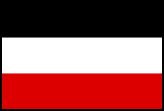
Gründung der Boon Rawd Bierbrauerei (บริษัท บุญรอดบริวเวอรี่ จำกัด). Die Produktionsanlage wird aus Deutschland für 400.000 Baht bezogen. Ein deutscher Experte leitet den Aufbau. Das Kapital der Brauerei ist 1 Mio. Baht. Kapazität: 30.000 Flaschen Bier pro Tag. In den ersten beiden Jahren beträgt die Rendite der Aktien 6%, schon 1938 beträgt die Rendite12%.
Abb.: Singha Lagerbier, 2009
[Bildquelle: Vivien. -- http://www.flickr.com/photos/octanou/3355543841/. -- Zugriff am 2012-04-05. -- Creative Commons Lizenz (Namensnennung, keine kommerzielle Nutzung)]
"Boon Rawd Brewery (Thai: บริษัท บุญรอดบริวเวอรี่ จำกัด) is an Asian brewery founded in 1933 [1] by Boonrawd Srethabutra in Thailand which also makes and sells soft drinks.[2] Their best known product is the pale lager Singha (สิงห์). [3] History
Boon Rawd Brewery was the first of its kind in Thailand, and produces beer under the Singha brand name. The brewery was founded by Boonrawd Srethabutra, on whom HM King Prajadhipok Rama VII bestowed the aristocratic title of Phraya Bhirom Bhakdi. The brewery is still under the management of the Bhirom Bhakdi family (3rd and 4th generations).
The Singha is a mystical lion, found in ancient Hindu and Thai stories. It is a powerful mythological creature and was chosen as a symbol. The Garuda symbol on the bottleneck is a symbol of Thailand's royalty. The Royal Warrant was given on October 25, 1939. Boon Rawd is the only Thai brewery to be granted Royal Permission to display it.[4]
Boon Rawd bought two German breweries in Hartmannsdorf and Mittweida in Saxony in 1994, which until 2001 produced Singha Gold for the European market. However, Singha beer has always been brewed and bottled in Thailand. Today, all of the Singha brands are produced only in Thailand, to preserve the original taste for the export market.
BrandsBoon Rawd produces Singha Beer, Singha Light Beer, Singha Soda Water, Singha Water, Leo Beer, Thai Beer, Moshi Green Tea, and B-ing Lifestyle Functional drink.
Bibliography[Quelle: http://en.wikipedia.org/wiki/Boon_Rawd_Brewery. -- Zugriff am 2012-04-05]
- Thailand Confidential, Jerry Hopkins, 2005, Tuttle Publishing Thailand, 256 pages, ISBN 079460093X"
1933

Gründung der Siamesisch-Deutschen Vereinigung. Gründer: Werner Peter Coqui, Vertreter der Firma Schering AG in Siam, und Phra Montri Botchanakitch [พระมนตรีพจนกิจ (หม่อมราชวงศ์ชาย ชุมแสง), 1885 - 1935], in Deutschland ausgebildeter Professor für Botanik an der Chulalongkorn University (จุฬาลงกรณ์มหาวิทยาลัย). Die Vereinigung hat anfangs 50 bis 60 Mitglieder.
"Die Siamesisch-Deutsche Vereinigung - Vorläufer der Thai-Deutschen Gesellschaft Ouay Ketusinh [อวย เกตุสิงห์, 1908 - ]
Das erste Freundschaftsabkommen zwischen Thailand und Deutschland wurde zur Zeit der Könige Chulalongkorn und Wilhelm I in der zweiten Hälfte des 19. Jahrhunderts unterzeichnet. Erst 1933 aber fand die Volk-zu-Volk-Beziehung ihren organisatorischen Ausdruck: Damals entstand die Siamesisch-Deutsche Vereinigung, deren Gründer der langjährige Vertreter der Firma Schering AG, Werner Peter Coqui, und der in Deutschland ausgebildete Professor für Botanik an der Chulalongkorn Universität [จุฬาลงกรณ์มหาวิทยาลัย], Phra Montri Botchanakitch [พระมนตรีพจนกิจ (หม่อมราชวงศ์ชาย ชุมแสง), 1885 - 1935], waren. Durch seine nette, großzügige Natur hatte Herr Coqui einen großen Kreis von Freunden und Bekannten unter den Siamesen, und Phra Montri war seinerseits bei den Deutschen bekannt und beliebt. Die Kombination der beiden Freunde besaß eine sehr starke Anziehungskraft, und binnen einiger Monate stieg die Mitgliederzahl auf fünfzig bzw. sechzig. Nach einigen Zusammenkünften im Hause Phra Montris an der Phya Thai Strasse bekam die junge Vereinigung in der Rama I Strasse, schräg gegenüber vom Wat Tchang Saeng, ihr eigenes Heim. Phra Montri wurde Präsident und Herr Coqui Vize-Präsident.
Der aus Siamesen und Deutschen zusammengesetzte Vorstand legte neben den gewöhnlichen gesellschaftlichen Aktivitäten wohlweislich die gebührenfreie Erteilung von Deutschunterricht als Haupttätigkeit der Vereinigung fest. Damals - anderthalb Jahrzehnte nach dem ersten Weltkrieg - wurde in den Schulen nur Englisch und Französisch gelehrt. Offiziell wurde der deutschen Sprache nur wenig Beachtung geschenkt. Als die Lehraktivität der Siamesisch-Deutschen Vereinigung bekannt wurde, erhöhte sich die Zahl der Mitglieder sehr schnell. Junge und alte Siamesen verschiedener Berufe meldeten sich für den Unterricht. Da es keinen ausgebildeten Deutschlehrer im Lande gab, mussten die Vorstandsmitglieder aushelfen. Als erste tat das Frau A. Goette, die im Vereinshaus mit ihrem Mann und Sohn wohnte und gleichzeitig als Sekretärin fungierte. Herr Rudolph Goette vertrat sie ab und zu, und wenn das Ehepaar verhindert war, spielte auch Herr Coqui Deutschlehrer.
Als die Anzahl der Studenten wuchs, mussten andere Deutsche herhalten. So wurden z.B. der Kunstmaler Hampe und der Apotheker Rudolph Schaller Amateur-Lehrer. Im Jahre 1935 kam durch die Vermittlung der Gesandtschaft ein ausgebildeter Philologe, Wolfgang Wagner, von der Deutschen Akademie in München. Er beschäftigte sich mit den Fortgeschrittenen, während Herr Elmar Rochga für die Anfänger sorgte. Gleichzeitig erteilte Dr. Wagner Deutschstunden an der Chulalongkorn Universität. Das war das erste Mal, dass dort planmäßig Deutsch unterrichtet wurde.Neben dem Deutschunterricht unternahm die Vereinigung noch folgende Aktivitäten: Tagungen, Vorträge, Exkursionen, Singabende, Theateraufführungen, Weihnachtsfeier u.s.w. Ab und zu lud der Gesandte die Mitglieder zu einer Festlichkeit oder zu einem deutschen Essen ein. Die sozialen Aktivitäten hinkten also dem Sprachunterricht nicht nach. Das galt besonders in der letzten Zeit der Vereinigung, als Herr Herbert Schwarz und seine Frau die Geschäftsführung übernommen hatten.
Der Deutschunterricht hatte eine große Auswirkung ; dies vor allem wegen der Stipendien der Alexander von Humboldt-Stiftung, die den besseren Studenten erteilt wurden. Von 1934 bis 1939 wurden rund zwanzig Stipendiaten ausgewählt und zur Fortbildung nach Deutschland geschickt. Die meisten waren Mediziner, aber auch Naturwissenschaft, Wirtschaft und Rechtswissenschaft waren vertreten. Mit Ausbruch des Weltkrieges wurde die Erteilung der Stipendien unterbrochen. Aber alle Stipendiaten, die bereits in Deutschland waren, konnten ihr Studium erfolgreich zum Abschluss bringen. Zurück in der Heimat wurden sie bevorzugt angestellt, und die meisten konnten für sich und das Vaterland erfolgreich tätig sein.
Auch während des Krieges liefen die Aktivitäten der Vereinigung weiter. Die Veranstaltungen waren immer gut besucht, trotz Schwierigkeiten, und die Vereinigung konnte sich bis zum Ende des Krieges halten. Dann mussten alle Aktivitäten aufhören, und die Siamesisch-Deutsche Vereinigung löste sich auf. Während der knapp 12 Jahre ihres Bestehens hatte sie nicht nur mit Erfolg die thai-deutsche Freundschaft vertieft, sie hatte auch durch die Vermittlung von Stipendien wichtige Fortschritte in der Wissenschaft Thailands, insbesondere in der Medizin, herbeigeführt. Möge ihre Nachfolgerin, die Thai-Deutsche Gesellschaft auf dem Erreichten erfolgreich aufbauen."
[Quelle: Ouay Ketusinh [อวย เกตุสิงห์] <1908 - >. -- In: 120 Jahre deutsch-thailändische Freundschaft = 120 ปีแห่งมิตรภาพ เยอรมัน-ไทย / Hrsg.: Botschaft d. Bundesrepublik Deutschland. Red.: Johannes Preisinger. -- Bangkok : Botschaft d. Bundesrepublik Deutschland , 1982. -- 186 S. : Ill. ; 20 cm. -- S. 119 - 121. -- Fair use]
Abb.: Werner Peter Coqui und Phra Montri Botchanakitch [พระมนตรีพจนกิจ (หม่อมราชวงศ์ชาย ชุมแสง)]
[Bildquelle: 120 Jahre deutsch-thailändische Freundschaft = 120 ปีแห่งมิตรภาพ เยอรมัน-ไทย / Hrsg.: Botschaft d. Bundesrepublik Deutschland. Red.: Johannes Preisinger. -- Bangkok : Botschaft d. Bundesrepublik Deutschland , 1982. -- 186 S. : Ill. ; 20 cm. -- S. 118. -- Fair use]
1933
Abb.: Reklame für Mosquito Coils, 1933
[Fair use]
1933
Eröffnung des Chalerm Krung Theater (ศาลาเฉลิมกรุง).
Abb.: Lage des Chalerm Krung Theater (ศาลาเฉลิมกรุง)
[Bildquelle: OpenStreetMap. -- Creative Commons Lizenz (Namensnennung, share alike)]
Abb.: Der Sangharaja [สังฆราช], Somdet Phra Sangkharat Chao Krommaluang Chinaworasiriwat (สมเด็จพระสังฆราชเจ้า กรมหลวงชินวรสิริวัฒน์, 1859 - 1937), und andere hohe Mönche bei der Einweihung des Chalerm Krung Theater (ศาลาเฉลิมกรุง), 1933[Bildquelle: How Theravāda is Theravāda? : exploring Buddhist identities / ed by Peter Skilling [1949 - ] ; Jason A. Carbine [1971 - ] ; Claudio Cicuzza ; Santi Pakdeekham [ศานติ ภักดีคำ, 1977 - ]. -- Chiang Mai : Silkworm, 2012. -- 620 S. : Ill. ; 22 cm. -- ISBN 978-616-215-044-9. -- S. 351. -- Fair use]
Abb.: Chalerm Krung Theater (ศาลาเฉลิมกรุง), 1933
Abb.: Chalerm Krung Theater (ศาลาเฉลิมกรุง), 2006
[Bildquelle: Heinrich Damm / Wikipedia. -- GNUFDLicense]
1933
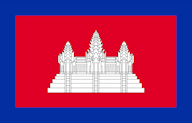
Kambodscha: Aufstände in der Provinz Battambang (ក្រុងបាត់ដំបង)
Abb.: Lage der Provinz Battambang (ក្រុងបាត់ដំបង)
[Bildquelel: CIA. -- Public domain]
"In 1933 the people of Battambang rose up against taxation. In the first five months of that year, French soldiers and police involved in the repression fought insurgents on seven occasions ... Of note was a movement led by two progressive monks, Achar Miet and Achar Prinh, in the 1933-35 period. Achar Miet joined the Buddhist Order in Siam and was influenced by the progressive democratic movement in Siam at that time. When he returned to Kampuchea he and Achar Prinh called on the people to struggle for democratic reforms. On the occasion of a Bon Kathen religious festival, they organized a meeting to protest the repressive and exploitative regime of French colonialism. The demonstration was repressed. Achar Miet was arrested. Shortly afterwards Achar Prinh died of illness.
There is no documentary evidence to show that these spontaneous movements were connected with the Indo-china Communist Party. But the progressive thought content of these movements clearly expressed the revolutionary demands of Kampuchea in the new era."
[Quelle: Tìm hiẻ̂u đá̂t nươc Campuchia anh hùng. -- Hà Nội : Khoa học xã hội, 1979. -- Übersetzt in: Kiernan, Ben <1953 - >: How Pol Pot came to power : Colonialism, nationalism, and communism in Cambodia, 1930 - 1975. -- 2. ed. -- New Haven : Yale UP, 2004. -- 430 S. : Ill. ;21 cm. -- ISBN 978-0-300-10262-8. -- S. 22f. -- Fair use]
1933

Deutschland: Markteinführung der ersten auf UV-Filterstoffen basierenden Sonnencreme: delial Salbe. Thais werden im Gegensatz zu diesen Bräunung zulassenden Mitteln Weißmacher bevorzugen.
1934

Abb.: 1-Baht-Banknote mit Bildnis Ramas VII.
1934
In jeder größeren Stadt gibt es Schönheitswettbewerbe. Das hält ab jetzt bis ins 21. Jahrhundert an.
"Fame and tragedy have come to the beauty winners. Miss Nakhon Sri Thammarat (นครศรีธรรมราช) was shot to death by the man she was to marry. He had been married before, but had concealed the fact from her and from her family. He was extremely jealous of the attentions showered upon her and kept pressing for an early marriage, which suited neither the girl nor her parents. The girl’s mother had consulted a priest who had selected an auspicious day some five months later than the date on which the young man wished to be married'. On a Sunday morning in the little roadside shop of the parents the four—father, mother, girl, and fiancé—sat discussing the matter. The girl sat with her head in her hands. She had a severe headache. Her fiancé pressed her again and again to set an early wedding day. Somewhat impatiently she replied: "I am ready to be married at any time my parents say. It is not a matter for me to decide." He stepped behind her and shot her through the head." [Quelle: Landon (1939), S. 160]
Abb.: Lage von Nakhon Sri Thammarat (นครศรีธรรมราช)
[Bildquelle: OpenStreetMap. -- Creative Commons Lizenz (Namensnennung, share alike)]
1934
Gründung der National Dance and Music School.
1934- 1937

Japan verbietet den Import von siamesischem Reis.
1934

Siamesische Kadetten und Offiziere werden nach Japan zur Fortbildung geschickt
1934

Auslieferung der Tankette Type 94 TK (九四式軽装甲車) an die japanische Armee. Diese Tankette ist für Kämpfe in tropischem Klima konzipiert. Über 800 Exemplare werden bis 1945 hergestellt.
Abb.: Type 94 TK (九四式軽装甲車), spätes Modell, 1938-1942
[Bildquelle: 日本陸軍 / Wikimedia. -- Public domain]
1933-04
Einführung verschiedener neuer Steuern, z.B. Stempelsteuer. Schätzung von Einkommen und Umsatz als Steuergrundlage. Die Einkommenssteuer beträgt 8%. Einkommen unter 2400 Baht jährlich sind steuerfrei. Einkommen über 12.000 Baht pro Jahr unterliegen einer Höchststeuer. Einkommen über 12.000 Baht pro Jahr aus Verpachtung von Immobilien unterliegt nur einer Höchststeuer, nicht der Steuer für Ackerland.
1933-04
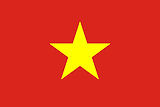
Kongress der ICP Indochinese Communist party (Đảng Cộng sản Đông Dương) in Ban Mai (บ้านใหม่, Thailand).
1933-04-01 - 1933-06-21
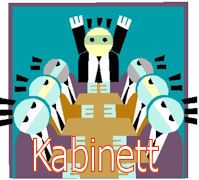
3. Kabinett: Manopakorn (มโนปกรณ์) III
1933-04-01
Ministerpräsident Manopakorn wendet sich mit einer Erklärung an die Öffentlichkeit und vertagt die Volksversammlung auf unbestimmte Zeit. Pridi wird von 1933-04-12 bis 1933-09-29 ins temporäre Exil geschickt mit einer Jahresrente von £1000. Das Exil wird als Studienreise bezeichnet. Der Abschied Pridis von Bangkok wird mit großem Pomp umgeben: es sind anwesend: 2000 Personen, 5 Minister, viele Mitglieder der Volksversammlung. Pridi wird als Geste der Loyalität bis Singapur u.a. vom Putschisten Captain Luang Tasnai Niyomsuk (Tasnai Mitrpakdi) (ร.อ.หลวงทัศนัยนิยมศึก (ทัศนัย มิตรภักดี), 1900 - 1933) begleitet. Tasnai stirbt am 10. Mai 1933 an einer Herzattacke. Gerüchte sagen, dass Leutnant Luang Phibulsonggram (พิบูลสงคราม, 1897 - 1964) am Tod beteiligt war, da er Tasnai seine Beliebtheit beim Militär neidete.
"The Government desires the people to understand the serious reasons that made it necessary to prorogue the present National Assembly, to form a new State Council and to suspend temporarily certain provisions of the Constitution. The present State Council is divided into two groups holding divergent and irreconcilable views. The minority desires to establish a new economic policy in Siam of a communistic nature. The majority deems such policy contrary to all the traditions of the Siamese people and certain to bring disaster to the people and menace the security of the State.
It is not to be expected that a State Council composed of twenty members will agree in all matters, but it is fundamental to orderly and efficient government that the body charged with executive power should agree on essential policies. The situation now existing would not be tolerated in any country whatever its form of government.
The present National Assembly contains only appointed members. Under the Constitution it exercises legislative powers until the new Assembly is created after an election. An Assembly so chosen and exercising power only for a temporary period should not attempt to establish an entirely new and subversive policy. While the Assembly has not passed any acts of this nature, it is clear that a considerable number of the members desire to do so, and are in sympathy with the extremist group in the State Council.
These fundamental divisions in the legislative and executive bodies are a serious menace to the stability of the State. They create delay and friction within the government and in the public mind fear and uncertainty for the future. This situation cannot be permitted to continue. The safety of the community is the supreme law of any state, and that law has compelled the Government to prorogue the Assembly and to create a new State Council. The Government desires to emphasize the fact that it has suspended only a few provisions of the Constitution and those only for the time being.
April 1st, 1933"
[Übersetzung: Landon (1939), S. 251]
1933-04-01
Premiere des Tonfilms หลงทาง (Going astray) / Regie: Khun Wichitmatra (Sanga Kanchanakphan) (ขุนวิจิตรมาตรา [สง่า กาญจนาคพันธุ์], 1897 - 1980)
Abb.: Filmplakat
1933-04-02

Gesetz über den Kommunismus (act concerning communism - พระราชบัญญัติว่าด้วยคอมมิวนิสต์). Bei der Formulierung half der außenpolitischen US-Berater Raymond Bartlett Stevens (1874 - 1942):
Abb.: Raymond Bartlett Stevens, 1919
[Bildquelle: LoC / Wikimedia. -- Public domain]
"ACT CONCERNING COMMUNISM Whereas any attempt to establish communism in Siam would bring disaster to the people and would menace the security of the State, It is hereby enacted by and with the advice and consent of the State Council, as follows:
Section i. This Act shall be called the "Act Concerning Communism."
Section 2. It shall come into force on and from the date of its publication in the Government Gazette.
Section 3. In this Act
- "Communism" means the economic system or theory, which rests upon the total or partial abolition of the right of private property, actual ownership being ascribed to the community as a whole or to the State.
- "Communistic doctrine" means any doctrine which implies the advocation of nationalization of land, or nationalization of industry, or nationalization of capital, or nationalization of labour.
Section 4. Whoever by words or writing or printed documents or by any means whatever advocates communism or any communistic doctrine shall be punished with imprisonment not exceeding ten years and fine not exceeding five thousand ticals.
Section 5. Whoever is the chief, manager or any official of any association secret or otherwise, the purpose of which is to advocate communism or any communistic doctrine, shall be punished with imprisonment not exceeding ten years and fine not exceeding five thousand ticals.
Any member of such association shall be punished with imprisonment not exceeding five years and fine not exceeding one thousand ticals."
April 2nd, 1933
[Übersetzung: Landon (1939), S. 251f.]
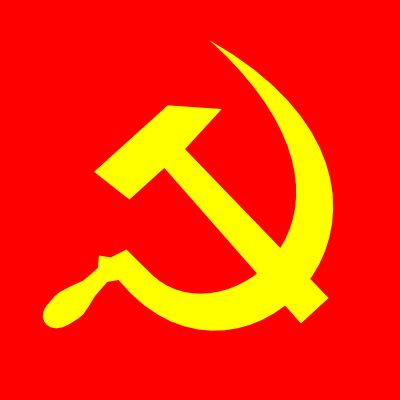
Abb.: Ab jetzt Kinderschreck der Nation: Kommunismus
1933-04-03
Bangkok Times schreibt über die "Radikalen", dass sie die meiste Zeit in Europa gelebt haben und die Thai Bauern, von denen wir alle leben, nicht verstehen.
1933-04-12

Royalisten verteilen Flugblätter mit folgendem Kommentar des Königs über Pridi:
"I do not know whether Stalin copied Luang Pradit (Pridi) or whether Luang Pradit copies Stalin The only difference is that one is Russian and the other is Thai... This is the same programme which has been used in Russia. If our government adopted it, we would have assisted the Third International to achieve its aim of world communism... Siam would have become the second communist state after Russia. If Siam got this position, it would delight nobody except Russia and the Third International. Other countries would be displeased, as we have already seen how hostile they are to Russia. Do we want them to become hostile to our country ?... As I have already mentioned, this would do more harm than good.
Those who say that they are not afraid of foreign invasion speak as though they were women who had become hysterical. It is plain to everyone that Siam’s position is quite different from that of Russia so far as the question of defense is concerned. Russia is much bigger than Siam, and consequently it' is difficult for anyone to invade her successfuly. Is it then right that we should lose our independence in order to satisfy Russia? ...
Hence, we should discard Luang Pradit’s (Pridi’s) economic plan, because it would bring trouble and disaster to our nation ... rather than happiness and prosperity."
[Zitiert und übersetzt in: Thawatt Mokarapong [ธวัช มกรพงศ์] <1932 - >: History of the Thai revolution : a study in political behaviour. -- Bangkok : Chalermnit, 1972. -- S. 158f..]
1933-04-19
Die Regierung verbietet jglichen - positiven oder negativen Kommentar zu Pridis Wirtschaftsplan (เค้าโครงการเศรษฐกิจ).
1933-04-19

Die USA verbieten die Ausfuhr von Gold. Damit verliert der Dollar den Goldstandard. Der Dollarkurs wird auf den internationalen Devisenmärkten frei gehandelt.
1933-04-27


Der deutsche Gesandte Erich August Karl Nord (1881 - 1935) ans Auswärtige Amt:
"Um König Prajadhipok selber rankten sich auch Gerüchte, die mit seinem Plan, wegen einer Augenoperation am Anfang des Jahres 1934 nach Amerika und Europa zu reisen, in Verbindung gebracht wurden. Wie Gesandter Nord dem Auswärtigen Amt in seinem Bericht vom 27. April 193313 mitteilte, spreche man in Siam zu dieser Zeit davon, dass der König von dieser Auslandsreise nicht wieder in das Land zurückkehren werde. „So unwahrscheinlich dieses Gerücht an sich klingt" - so der Gesandte - „sprechen doch allerlei Anzeichen dafür, dass der König zum mindesten mit diesem Gedanken gespielt hat oder noch spielt". Ebenfalls sei es ein offenes Geheimnis, dass der König sich in seiner Hauptstadt nicht mehr sicher fühle und sie nur ungern betrete. Deswegen glaube man auch daran, dass seine Abdankung nur eine Frage der Zeit sei. Weiterhin berichtete Nord, dass, als ein französisches Torpedoboot Bangkok kurz vor der Berichterstattung einen Besuch abstattete, es hier geheißen habe, der König wolle sich unter den Schutz dieses Schiffes begeben. Parallel zu den Gerüchten über König Prajadhipok spielte ein weiteres Gerücht um die Person des Prinzen Cunla Cakkaphong [จุลจักรพงษ์, 1908 - 1963], der zu dieser Zeit in London verweilte und eine enge Verbindung zu dem dortigen Königshaus unterhielt, eine nicht unerhebliche Rolle. Da Nord zufolge dieser Prinz unlängst vor seiner Berichtserstattung eine große Summe von 200.000 Ticals der siamesischen Unterrichtsverwaltung gestiftet und eine Zeichnung von 800.000 Ticals für die neu aufgelegte innere siamesische Staatsanleihe ankündigen lassen habe, bringe man in Siam seine Großzügigkeiten mit dem Abdankungsgerücht des Königs in Verbindung. Doch die Vorstellung, Prinz Cunla Cakkaphong könnte den siamesischen Thron übernehmen, erschien ihm schon aufgrund der Tatsache, dass der Prinz eine russische Mutter hatte und deswegen als Thronbewerber ausscheiden musste, unrealistisch. Dabei meinte Nord, dass es
„für das siamesische Land ein schweres Unglück bedeuten würde, wenn es seinen König, den man wohl als den loyalsten Diener seines Vaterlandes bezeichnen kann, in der jetzigen Krisenzeit verlieren würde".
Dem Gesandten Nord zufolge hatte sich zu den erwähnten Gerüchten noch eine Verstimmung hinzugesellt. Die siamesische Regierung habe die in alter Tradition verwurzelten königlichen Zeremonien beschnitten, ohne den König erst um sein Einverständnis zu bitten. So habe die Regierung die sonst drei Tage andauernden Festlichkeiten anlässlich der auf Februar fallenden Thronbesteigung und des Geburtstags des Königs auf einen Tag gekürzt. Darauf habe der König mit seinem Wegbleiben aus Bangkok sowie der Abschaffung der Treueidleistungszeremonie [พิธีถือน้ำพระพิพัฒน์สัตยา], bei der alle Staatbeamten geweihtes Wasser als Zeichen ihrer Treue zum Königshaus zu trinken haben, geantwortet."
[Quelle: Catthiyakorn Sasitharamas [คัททิยากร ศศิธรามาส]: Die deutsch-thailändischen Beziehungen in der Zeit der Weimarer Republik bis zum Ende des Zweiten Weltkriegs. -- Hamburg : Kovač, 2012. -- 346 S. ; 21 cm. -- (Schriftenreihe Schriften zur Geschichtsforschung des 20. Jahrhunderts ; Bd. 4). -- ISBN 978-3-8300-6361-2. -- Zugl.: Hamburg, Univ., Diss., 2012. -- S. 205ff. -- Fair use]
1933-05
Gründung einer Propagandaabteilung (กรมโขษณาการ) nach dem Vorbild des nationalsozialistischen Reichsministeriums für Volksaufklärung und Propaganda von Joseph Goebbels (1897 - 1945)
1933-05-01

Der Mahathera Samakhom [มหาเถรสมาคม] verbietet Mönchen und Novizen die Mitgliedschaft in Laienorganisationen.
1933-05

Gründung der Social Oil Company, einer Agentur der United Petroleum Company der Sowjetunion. Startkapital: 500.000 Baht.
1933-05
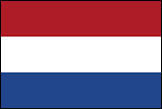
Niederländisch-Ostindien (Indonesien) erlaubt Reisimport nur noch mit spezieller Bewilligung.
1933-05-31

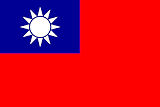
Tanggu (塘沽区): Waffenstillstand (塘沽協定) zwischen Japan und China.
Abb.: Im Waffenstillstand festgelegte entmilitarisierte Zone
[Bildquelle: Wikipedia. -- Public domain]
1933-06
Eröffnung der Bahnlinie Nakhon Ratchasima (นครราชสีมา) - Khon Kaen (ขอนแก่น)
Abb.: Eisenbahnlinie Nakhon Ratchasima (นครราชสีมา) - Khon Kaen (ขอนแก่น)
[Bildquelle: CIA. -- Public domain]
1933-06-10
Es erklären ihren Rücktritt von ihren Regierungsämtern und militärischen Stellungen zum 1933-06-24, dem Jahrestag des Putsches:
Colonel Phya Phahon Phonphayuhasena (พลเอก พระยา พหลพลพยุหเสนา, 1889-1958)
Phraya Songsuradet / Phraya Song (พระยาทรงสุรเดช, 1891/ 1892 - 1944)
Colonel Phraya Ritthi Akaney (Sala Emsiri) (พ.อ. พระยาฤทธิ์อัคเนย์ (สละ เอมะศิริ), 1889 - 1966), Landwirtschaftsminister
Colonel Phra Prasat Pitthiyayuthi (Wan Chuthin) (พ.ท. พระประสาสน์พิทยายุท (วัน ชูถิ่น), 1894 - 1949)
Die vier sind als die vier Musketiere (4 ทหารเสือ = Tigersoldaten).
1933-06-16

Beginn des New Deal in den USA, der "Neuverteilung der Karten im Kartenspiel" (new deal): Wirtschafts- und Sozialreformen zur Überwindung der Weltwirtschaftskrise.
Abb.: Arbeitslosenquote in den USA 1910 - 1960
[Bildquelle: Lawrencekhoo / Wikipedia. -- Public domain]
1933-06-20

Militärputsch: Colonel Phya Phaholpholphayuhasena (พลเอก พระยา พหลพลพยุหเสนา,1889-1958) und seine Militärs verhaften Ministerpräsident Phya Manopakorn (พระยา มโนปกรณ์ นิติธาดา, 1884 - 1948) und andere konservative Führer. Die Regierung muss zurücktreten. Die Putschisten schicken ein Telegramm an den König:
"To H. S. H. Prince Vipulya Svastivongse, His Majesty’s Private Secretary; Now that it is necessary for the Army and Navy to seize the control of the Government with the intention merely to convene the Assembly of the People’s Representatives, please therefore convey this information to His Majesty, and also inform His Majesty that the Army and Navy are as always filled with respect and have faith in His Majesty.
Colonel Phya Bahol Balabayuha [พลเอก พระยา พหลพลพยุหเสนา
]
Lt.-Colonel Luang Pibul Songgram [แปลก พิบูลสงคราม]
Commander Luang Subha Jalasaya"[Übersetzung: Landon (1939), S. 32]
1933-06-20

On June 20, 1933. a coup d'etat was effected, Yatabe's [Yasukichi Yatabe - 矢田部保吉, japanischer Gesandter] presence, at the coup headquarters, was requested. He went secretly and a 1½ hour secret meeting with Pahol and Pibul took place. Yatabe was told that Slam could expect only hostility from European Powers. Thus consolidation of Siam's prosperity now relied solely on Japan. In reply, Yatabe congratulated Pahol and went on to stake a claim for a bigger share in Siamese commerce. Once assured, he urged the economic development of Siam through Japanese technology and capital, that commercially Japan should be treated as the equal of Britain and that Japanese advisers be attached to the Siamese government. This became a historic, secret, verbal understanding, though without any secret alliance. The significance of this mutual understanding was that the Japanese now had much easier access to the real ruling group in Siam. However, it has to be said too that this came as a result of the Siamese leaders' fear of European wrath rather than an admiration of Japanese foreign policy goals, at least during 1933." [Quelle: Charivat Santaputra [จริย์วัฒน์ สันตะบุตร]: Thai foreign policy 1932-1946. -- Bangkok : Thai Khadi Research Institute, Thammasat University, 1985. -- 465 S. ; 21 cm. -- ISBN 974-335-091-8. -- S. 118]
1933-06-21 - 1938-12-16
Colonel Phya Phahon Phonphayuhasena (พลเอก พระยา พหลพลพยุหเสนา, 1889-1958) ist Ministerpräsident (นายกรัฐมนตรีแห่งราชอาณาจักรไทย - Prime Minister)
Abb.: Colonel Phya Phaholpholphayuhasena (พลเอก พระยาพหลพลพยุหเสนา)
"Phraya Phahon Phonphayuhasena (andere Schreibweise: Phya Phahol Phonpayuhasen, genannt Phraya Phahon, Thai: พระยาพหลพลพยุหเสนา; * 29. März 1887 in Bangkok; † 14. Februar 1947 ebenda) war Premierminister von Thailand. Phraya Phahon wurde in Bangkok als Phot Phahonyothin, Sohn von General Phraya Phahon Phonpayuhasena (Thin Phahonyothin) und Jub Phahonyothin geboren. Er heiratete später Boonlong Phahon Phonpayuhasena.
Seine Ausbildung begann er an der Schule des Wat Chakkrawat-Ratchawat (Thai: วัดจักรวรรดิราชาวาส, kurz: วัดสามปลื้ม - Wat Sampluem) und am Sukuman College (Thai: สุขุมาลวิทยาลัย). Er setzte seine Studien weiter fort an der Kadettenakademie der thailändischen Armee und konnte mit 16 Jahren ein Stipendium der Regierung erhalten, um seine Studien in Deutschland an der Preußischen Hauptkadettenanstalt in Lichterfelde-West bei Berlin fortzusetzen. Nach dem Abschluss trat er in das 4. Artillerie-Infanterieregiment der preußischenArmee ein. 1912 setzte er seine Ausbildung in Dänemark weiter fort, wurde aber bereits 1913 zurückberufen, da die Geldmittel ausgingen.
Phraya Phahon setzte seine militärische Karriere im 4. Feldartillerie-Regiment der Provinz Ratchaburi fort und kam drei Jahre später in das Hauptquartier der Artillerie von Bang Sue, Bangkok. 1917 wurde er Kommandeur des 9. Feldartillerie-Regiments von Chachoengsao. Hier erhielt er die Titel Luang und Phra Sara Yut Son Sit (Thai: สรายุทธสรสิทธิ์) wegen seiner außerordentlich guten und aufopferungsvollen Leistungen in der Armee. Am 1. April 1928 wurde er zum Oberst ernannt.
Am 20. Mai dieses Jahres kam er zur königlichen Garde und am 6. November 1931 erhielt er wie sein Vater den Titel eines Phraya Phahon Phonpayuhasena.
Am 24. Juni bildete er nach einem unblutigen Putsch das „Öffentliche Komitee“ (eine Art Kabinett), um die absolute Monarchie abzuschaffen und durch eine konstitutionelle Monarchie mit einer neuen Verfassung zu ersetzen.
Oberst Phraya Phahon Phonpayuhasena wurde am 21. Juni 1933 nach einem weiteren Putsch zum Premierminister von Thailand ernannt und amtierte bis zum 11. September 1938. Während dieser Zeit hatte er mit vielen Problemen zu kämpfen. So rebellierte 1934 ein Teil der Armee unter Prinz Bovoradej (พระวรวงศ์เธอ พระองค์เจ้าบวรเดช). Im Jahr 1937 kam es zum Skandal, als bekannt wurde, dass ein großer Teil des Vermögens der Krone unter Marktpreisen an hohe Beamte verkauft worden war. Nach Neuwahlen in 1938 wurde das Kabinett schließlich zum Rücktritt gedrängt.
Während seiner Regierungszeit werden die allgemeine Schulpflicht eingeführt und die Ausgaben für das Bildungswesen vervierfacht.
Anschließend wurde er während des 2. Weltkriegs Oberkommandierender der Thailändischen Streitkräfte und wurde deshalb zum General ernannt.
Phraya Phahon Phonpayuhasena starb am 14. Februar 1947 60-jährig an einem Gehirnschlag.
WissenswertesThailands „Highway Nr. 1“, der vom Victory Monument im Bangkoker Stadtteil Ratchathewi bis hinauf zur Grenze nach Myanmar in der Provinz Chiang Rai führt, wird Phraya Phahon zu Ehren Phahonyothin Highway (Thai: ถนนพหลโยธิน) genannt."
[Quelle: http://de.wikipedia.org/wiki/Phahol_Pholphayuhasena. -- Zugriff am 2011-10-06]
Eine der ersten politischen Erklärungen Phahons:
"No element of communism shall ever creep into Siam as long as I possess any influence in the government. I will devote my life to protect the Constitution under our Most Gracious Majesty." [Übersetzt in Landon (1939), S. 34]

Phahon nimmt sofort geheimen Kontakt mit der japanischen Gesandtschaft auf. Der japanische Gesandtschaft rät, dass Siam sich aus der Umklammerung durch Großbritannien befreit und sich für Investitionen und technische Experten an Japan wenden soll. Phahon stimmt zu. Beide Seiten beschließen, dass das Trefefn streng geheim bleiben soll.
1933-06-21 - 1933-12-16

4. Kabinett: Pahon (พหลโยธิน) I
1933-07
Erstmals bittet ein Staatsbeamter darum, dass er anstelle seines Titels seinen ursprünglichen Namen tragen darf: statt Luang Sundara Asvaraj (หลวง สุนทร อัศวราช) heißt er nun Nai (นาย) Chamras Soravisutr.
"Feudal lifetime titles for male commoners (all obsolete) These titles were given only to males and not inheritable much like a life peerage. European equivalents were also used on diplomatic missions.[1] While all are obsolete as feudal titles, note that Phan, Nai, and Phrai have modern word usages.
Somdej Chao PhrayaSomdej Chao Phraya (สมเด็จเจ้าพระยา) is the most senior among the ranks. It is awarded under extraordinary circumstances only to those with great achievements. This title is equivalent to that of a prince or Grand Duke.
There have only been four persons in Siam's history to be elevated to this title. The first was granted by King Taksin of Thonburi to Chao Phraya Chakri who later become King Rama I of Bangkok; three more were granted to members of the House of Bunnag: two by King Rama IV and the last by King Rama V.
Chao PhrayaChao Phraya (เจ้าพระยา) is the most senior rank commonly granted. It is normally bestowed upon commoners who served as Ministers of State. Holders of this title are informally addressed and referred to as "Chao Khun" (เจ้าคุณ) (2nd person: Chao Khun; 3rd person: Chao Khun + [honorific name]). This title is equivalent to Duke. The Chao Phraya River that runs through Bangkok was once known simply as Menam (แม่น้ำ maenam,) the generic term for river; the full names signifies that it is the chief river in the kingdom[4].
PhrayaPhraya (พระยา) is next in term of seniority. Similar to Chao Phraya, holders of this title are also informally addressed and referred to as "Chao Khun" (เจ้าคุณ). This title is equivalent to Marquess or Marquis.
Phra and Jamuen (or Phranai)Phra (พระ) is further down the line. Holders of this title are informally addressed and referred to as "Khun Phra" (คุณพระ) (2nd person: Khun Phra; 3rd person: Khun Phra + [honorific name]).
Jamuen (จมื่น หรือ พระนาย) is a senior title equivalent to Phra, given only to the Head of the king's servants (มหาดเล็ก). The European equivalent to this title is Count or Earl.
LuangLuang (หลวง). Still further down the line, holders of this title are informally addressed and referred to as "Khun Luang" (คุณหลวง) (2nd person: Khun Luang; 3rd person: Khun Luang + [honorific name]). Equivalent to viscount.
KhunKhun (ขุน). Pronounced with rising tone, as opposed to mid-tone courtesy title Khun (คุณ). Holders of this title are informally addressed as "Than Khun" (ท่านขุน). The last living holder was believed to be Pol Maj-Gen Khun Phantharak Rajadej (Butr Phantharak) who died in 2006, age 103. Equivalent to Baron.
MuenMuen (หมื่น) is one of the lower ranks, usually held by relatively junior officers; muen is also Thai numeral 10,000 – see Phan, below.
PhanPhan (พัน), a yet lower rank, and not considered very noble. This title was formerly held by junior officials, especially those in rural areas. Phan is also the Thai numeral thousand. In the current military ranks of the Thai armed forces, Phan Ek (พันเอก) is First of 1,000 or Colonel; Phan Tho (พันโท) Second of 1,000, a Lieutenant Colonel.
NaiNai (นาย) – one step up from Phrai plain commoner – is the most junior of the ranks, and not normally considered noble. Nowadays used as an equivalent for Mister, with Nang Sao (นางสาว) the equivalent of Miss and Nang (นาง) the equivalent of Mrs or Ms Related terms: Chao Nai (เจ้านาย) either royalty or boss; Moon Nai or Chao Khun Moon Nai (มูลนาย หรือเจ้าขุนมูลนาย) master (of Phrai Som.)
PhraiPhrai (ไพร่) – Common people having no sakdina – ostensibly above the seven categories of slave (ทาส) but subject to corvée for three months out of the year. Related terms: Phrai Luang, (ไพร่หลวง) in service to the sovereign; Phrai Som (ไพร่สม), under a master; Phrai Tahan (ไพร่ทหาร), soldier; Phrai Suay (ไพร่ส่วย) making payment in kind (cattle) in lieu of service. After the abolition of corvée and slavery in 1905, the term fell into disuse as unmannerly in favor of khon saman (คนสามัญ) commoner; khon thammada (คนธรรมดา) ordinary person of no specified social status; or khon pokati (คนปกติ) normal person. Compare churl and the trifunctional hypothesis of Proto-Indo-European society. Phrai reemerged during the 2008–2010 Thai political crisis as an epithet used for (and by) Redshirt protesters."
[Quelle: http://en.wikipedia.org/wiki/Thai_royal_and_noble_titles#Feudal_lifetime_titles_for_male_commoners_.28all_obsolete.29. -- Zugriff am 2012-03-08]
1933-07
Dr. Joti Kumbandh [โชติกุมพันธ์] bildet eine nationalistische Gruppe mit den beiden Zielen:
- "Opposition to those who do not respect the nation and who recognize those of other nationally ties and tongues to be better than their own people"
- "Constantly to try and remind foreigners to keep In mind that they are seeking shelter in this country as guests."
[Zitiert in: Charivat Santaputra [จริย์วัฒน์ สันตะบุตร]: Thai foreign policy 1932-1946. -- Bangkok : Thai Khadi Research Institute, Thammasat University, 1985. -- 465 S. ; 21 cm. -- ISBN 974-335-091-8. -- S. 159f.]
Ende 1933 bittet Ministerpräsident Phahon Dr. Joti die Bewegung aufzulösen, da sie anti-europäische Resentiments wecke und die Regierung schon sonst genügend Probleme hat.
1933-07-01
Bangkok Daily Mail (Inhaber: Prinz Svasti - สมเด็จพระเจ้าบรมวงศ์เธอ พระองค์เจ้าสวัสดิโสภณ กรมพระสวัสดิวัดนวิศิษฎ์, 1865 - 1935 - Schwiegervater von Rama VII.):
"Why the Chinese people are not allowed to spend their own money in their own private schools without being burdened down with the law that four hours of every day must be devoted to the study of Siamese is a situation we cannot understand. To study Siamese is imperative admittedly, but to ruin private schools for anything else but that smells very much like class legislation to us. These Chinese children are future citizens of Siam. They will pay taxes, marry, and vote here. Most of them will be good citizens. Then why should they be forced to go to Swatow [汕头] because they want to learn Chinese as well as Siamese? Why should the government cut the hours in the Chinese schools that can be devoted to the Chinese language to such an extent that the learning of that language becomes well nigh impossible? Learning the Chinese language so that it can be spoken and written correctly is a long-time process. It takes far longer than learning Siamese. It is indeed strange that some kind of compromise measure could not have been arrived at after the Chinese residents here presented their petition."
[Zitiert in: Landon, Kenneth Perry <1903 - 1993>: The Chinese in Thailand. -- Londondon : Oxford UP, 1941. -- 310 S. ; 23 cm. -- (International Research Series of the Institute of Pacific Relations). -- S. 272]
1933-07-04

Beginn der Regenzeit: erstmals spricht ein siamesischer König über Radio direkt zum Volk wegen einer Krise: Rama VII. fordert Einigkeit und Selbstaufopferung vom Volk.
1933-07-06

Der US-Diplomat Lynch an das Außenministerium:
"While some form of counter-revolution would not come as a surprise to the Legation, at the present time it fails to see any man with sufficient influence in the army or the navy to bring it about successfully. The sources of discontent are there, however, and with a considerable number of able and popular army and navy officers prematurely on the retired list a leader might conceivably come from that group." [Zitiert in: Batson, Benjamin Arthur <1942 - >: The end of the absolute monarchy in Siam. -- Singapore : Oxford Univ. Pr., 1984. -- 349 S. : Ill. ; 22 cm. -- (Southeast Asia publications series ; no. 10). -- ISBN 0-19-582612-4. -- S. 246]
1933-07-16

Die halboffiziöse Zeitung Srikrung Daily News bringt einen Bericht über einen angeblichen Putschversuch.
1933-07-20
Bangkok Times Weekly Mail veröffentlicht ein vertrauliches Rundschreiben von Leutnant Luang Phibulsonggram (พิบูลสงคราม, 1897 - 1964) und Luang Supha Chalasai (หลวงศุภชลาศัย, 1895 - 1965)
"Both times the Khana Ratsadorn [คณะราษฎร] seized power, it acted in an orderly fashion for the sake of peace and the freedom of the people. It appears from our investigations that you are trying to destroy that peace by attempting to overthrow the present government. Such a move would interfere with the orderly progress of the nation. In our position as guardians of the peace, we advise you to desist. If you insist on causing trouble, our group will use strong measures to assure the peace. This is not a threat we signed to intimidate you, but is advice hopefully given." [Zitiert in: Stowe, Judith A. <1934 - 2007>: Siam becomes Thailand : a story of intrigue. -- Honolulu : Univ. of Hawaii Pr., 1991. -- 394 S. : Ill. ; 22 cm. -- ISBN 0-8248-1394-4. -- S. 55f.]
1933-07-24 - 1933-08-05

Regina, Kanada: World’s Grain Exhibition and Conference. Siam nimmt teil. Bei der Reisqualität gewinnt Siam 11 von 20 Preisen.
Abb.: Lage von Regina
[Bildquelle: OpenStreetMap. -- Creative Commons Lizenz (Namensnennung, share alike)]
Abb.: Gedenkbriefmarke
1933-07-25
Über Quacksalber:
"The writer can state without hesitation or exaggeration that large numbers of simple ignorant villagers are not only made to part with their money under false pretences, but are also disabled, mutilated or maimed, and sometimes poisoned and killed by the injudicious use of potent drugs and improper irresponsible administration of injections by quacks. . . . The writer visited some Chinese mining camps and came across one of these medicine pedlars. This gentleman was dressed in full European costume with stiff collar, necktie, riding breeches and leggings. He was wearing gold rimmed spectacles and had a stethoscope displayed in one of his pockets. The writer had a unique opportunity of observing the gentleman in action who was holding forth the most wonderful tales of surgical feats he could perform, such as that of removing the brain, cleaning it and putting it back. He was also prepared to give a written guarantee to cure leprosy, consumption, sterility and impotency in men, and barrenness in women, by a single injection and a bottle of medicine, the value of which, however, would have to be paid half in advance and half after the cure. He also explained to the simple folk gathered there that he had an injection which when given would perfume the body so that when one sweats, a most exquisite odour would emanate from the body. In the course of his practice the writer has come across cases of Chronic Bronchitis, Asthma, Tuberculosis, Heart Disease, Kidney Disease, Hernia, Hydrocele, etc., who give a definite history of having received four or five intravenous injections, which from the description of the packing is without doubt Neo Salvarsan, the use of which drug is much abused in Siam. The writer has personally seen numbers of people who are unable to bend the elbow due to inflammation caused by the unskillful intravenous injection of Neo Salvarsan where the major part of the solution escaped into the subcutaneous tissue."
[Quelle: Bangkok Times. -- 1933-07-25. -- Zitiert in: Landon (1939), S. 124f.]
Abb.: Wird in Siam als Allheilmittel verwendet: Neosalvarsan
[Bildquelle: http://www.paul-ehrlich.de/Research/research.htm. -- Zugriff am 2012-03-04]
1933-07-31
Pridi Phanomyong (ปรีดี พนมยงค์, 1900 - 1983) gibt in Paris der Agentur Reuters ein Interview. er sagt, dass er einige Industrien und Dienstleitungen verstaatlichen möchte. Er verneint aber, ein Kommunist oder Mitglied der Dritten Internationale (Komintern / Коминтерн, 3-й Интернационал) zu sein. Er sagt seine Ideen seien identisch mit denen der britischen Labour Party. Er werde nicht nach Siam zurückkehren, es sei denn er werde von der Regierung eingeladen.
1933-08


"Given such obsessive concern over foreign intervention, the King had not felt free since June 1932 to receive any of his Western friends, fearing that such meetings would be misconstrued by the promoters. His self- restraint finally snapped after fourteen months. In identical letters addressed to at least two of the British advisers attached to the government, the King showed just how pessimistic he had become. Although he conceded that a few diehards "out of touch with reality" wanted to see the return of the absolute monarchy, there were far more monarchists who were prepared to accept the constitution. The problem was that they had been betrayed by Phya Mano [Phraya Manopakorn Nititada, พระยามโนปกรณ์นิติธาดา, 1884 - 1948)]. In a scathing criticism of his previous Prime Minister, the King complained that he had failed to listen to advice or pay any attention to popular feeling, thus precipitating his own downfall by unwisely proroguing the Assembly. As a result those people who were politically conscious had no alternative but to team up with the communists. In propounding this thesis the King discounted the military, except in so far as they had guns. Those who supported Pridi [ปรีดี พนมยงค์, 1900 - 1983] were far more dangerous, because he wanted to establish a republic yet was clever enough to realise that such an objective could not be achieved overnight. Hence the King claimed that Pridi’s followers had embarked on a scabrous campaign to discredit the royal family, and the only way to stop it was to use the bogey of foreign intervention, the one thing of which Pridi and his friends were afraid. The King therefore concluded his letter by suggesting that all foreign advisers attached to the government should resign as a warning against the forthcoming establishment of a communist regime." [Quelle: Stowe, Judith A. <1934 - 2007>: Siam becomes Thailand : a story of intrigue. -- Honolulu : Univ. of Hawaii Pr., 1991. -- 394 S. : Ill. ; 22 cm. -- ISBN 0-8248-1394-4. -- S. 56f.]
1933-08

Teile der Kriegsmarine unter Führung von Vizeadmiral Phraya Rajawangsan (Sri Kamalanavin) (พล.ร.ท.พระยาราชวังสัน (ศรี กมลนาวิน), 1886 - 1939) planen einen Putsch. Deswegen wird der Befehlshaber der Marine abgesetzt.
1933-08-30

Gründung der französischen Fluggesellschaft Air France aus der Fusion verschiedener Fluggesellschaften. Air France fliegt auf der Linie nach Saigon (Vietnam) Bangkok an.
Abb.: ®Logo
[Bildquelle: Wikipedia]
1933-09

Der König amnestiert alle politischen Häftlinge mit Ausnahme der Kommunisten.
1933-09

Um die Anschlüsse von Air France nach Indochina zu erreichen, beschließt die britische Fluggesellschaft Imperial Airways nicht Rangoon (Britisch-Burma) sondern Bangkok zum Hub für die Flüge nach Hongkong und Australien zu machen.
Abb.: Asien-Routen von Imperial Airways 1937
1933-09

"In September, 1933. the Japanese Legation in Bangkok learnt with fear that a Japanese South Seas businessman, Iizuka Shigeru [飯塚茂], was engaged in a Siamese political plot, on the royalist side too. Apparently, Iizuka acted as a contact man for Prince Nakornsawan [Paribatra Sukhumbhand, Prince of Nakhon Sawan - สมเด็จพระเจ้าบรมวงศ์เธอ เจ้าฟ้าบริพัตรสุขุมพันธุ์ กรมพระนครสวรรค์วรพินิต, 1881 - 1944] in his plot to overthrow Pahol's government. Iizuka professed that his objectives for Japan were the same as Yatabe's [Yasukichi Yatabe - 矢田部保吉, japanischer Gesandter] but his methods were not. He would try to draw Prince Nakornsawan into the Japanese camp. Yatabe, who was resting in Japan, was frightened, lest the Siamese public knew of Iizuka's connection with this plot. Yatabe and his staff in Bangkok tried to stop this foolhardy action. Before anything happened, Bovoradej's rebellion [กบฎบวรเดช], which could be a result of Ilzaka's go-between activity, broke out on October 12, 1933. Iizuka's role in this rebellion could not be established. Fortunately for Japan, his support of Prince Nakornsawan never became known. " [Quelle: Charivat Santaputra [จริย์วัฒน์ สันตะบุตร]: Thai foreign policy 1932-1946. -- Bangkok : Thai Khadi Research Institute, Thammasat University, 1985. -- 465 S. ; 21 cm. -- ISBN 974-335-091-8. -- S. ]
1933-09-01

Der König erlaubt die Rückkehr von Pridi Phanomyong (ปรีดี พนมยงค์, 1900 - 1983), nachdem dieser eine Erklärung unterschrieben hat, sich an die grundlegenden Wirtschaftsprinzipien zu halten, die ein Komitee unter Phraya Manopakorn Nititada (พระยามโนปกรณ์นิติธาดา, 1884 - 1948) im April 1933 festgelegt hat.
Die Regierung betont, dass im Fall, dass Landwirtschaftskooperativen eingereichtet oder Industrie staatlich unterstützt würde, alle bestehenden Eigentumsrechte voll respektiert würden.
1933-09-15

Thawat Riddhidej (ถวัติ ฤทธิเดช, 1894 - 1950), der Sekretär der Straßenbahnergewerkschaft, erhebt Anklage gegen Rama VII., da dieser in seinem "Weißen Buch" (สมุดปกขาว) geschrieben hat, dass der Straßenbahnerstreik von Opportunisten angezettelt sei, die ihr Gehalt als Gewerkschaftsführer retten wollen. Thawat wird daraufhin wegen Rebellion und Majestätsbeleidigung festgenommen. Thawat appelliert im Oktober an die Volksversammlung, die im November gegen Thawat entscheidet.
Abb.: Thawat Riddhidej (ถวัติ ฤทธิเดช)
[Fair use]
1933-09-15
Abb.: Siam Movie Magazine, 1933-09-15
1933-09-15


Der britische Konsul Bailey an John Allsebrook Simon, 1st Viscount Simon (1873 – 1954), Secretary of State for Foreign Affairs:
"Undoubtedly the Japanese have been taking a keen interest in Siam and would like perhaps to pose as its protectors against the European: and some young Siamese may be inclined to regard Japan as such.... The Japanese, with Manchuria [滿洲國] on their hands, could hardly contemplate armed intervention in Siam; they have good reason to be interested in the country commercially.... I do not think they can have any Pan-Asiatic designs on Siam " [Zitiert in: Charivat Santaputra [จริย์วัฒน์ สันตะบุตร]: Thai foreign policy 1932-1946. -- Bangkok : Thai Khadi Research Institute, Thammasat University, 1985. -- 465 S. ; 21 cm. -- ISBN 974-335-091-8. -- S. 117]
1933-09-16
Prinz Chula Chakrabongse (จุลจักรพงษ์, 1908 – 1963) gibt seinen Pächtern ein Fest, zu dem er 1600 Personen einlädt.
1933-09-23
Phraya Songsuradet / Phraya Song (พระยาทรงสุรเดช, 1891/ 1892 - 1944) und Colonel Phra Prasat Pitthiyayuthi (Wan Chuthin) (พ.ท. พระประสาสน์พิทยายุท (วัน ชูถิ่น), 1894 - 1949) werden auf "Studienreise" nach Europa, d.h. ins vorläufige Exil geschickt. Sie erhalten ihr volles Gehalt plus Tagesgeld.
1933-09-23
Pridi Phanomyong (ปรีดี พนมยงค์, 1900 - 1983) kehrt von seiner "Studienreise" nach Europa nach Bangkok zurück. Zwei Tage später wird er zum Minister ohne Portfolio ernannt.
1933-10

Abb.: Inserat für das Filmmusical "42nd Street "(1932)
1933-10-05
Ausführliche Debatten darüber, ob Polygamie gesetzlich erlaubt bleiben soll, führen zum Beschluss, die Entscheidung auf später zu verschieben.
"The question that took up so much time (of the Assembly of Representatives) was the report of the Commission appointed to consider the draft of Book V of the Commercial and Civil Code dealing with the family. The point raised was whether a man should be empowered to register only one wife or several wives. Perhaps certain facts pertaining to this point may be of interest. Originally the Department for Legislative Redaction submitted the draft of this law to the Assembly of the first period, when it was referred to the Commission dealing with draft laws. The Commission agreed first to hear the views of the members of the Assembly on this important point, whether a man ought to have only one or several wives. On or about the 5th of October last, Colonel Phya Bahol, the Premier in the former Government, submitted his opinion to the Commission that the point as to the number of wives a man should have was a most' vital one, which would bring forth an important climax similar to a world split, and therefore it should not be settled then, but should be left to the Assembly of the second period to decide, because then there would be members elected by the people present to give their final decision." [Quelle: Bangkok Times. -- 1934-01-19. -- Zitiert in Landon (1939), S. 254f.]
1933-10-09


US Gesandtschaft Bangkok: Monthly political report for September 1933:
"Die chinesische Regierung habe der Mitteilung der amerikanischen Gesandtschaft in Bangkok in ihrem „Monthly Political Report" für September 1933 zufolge angekündet, Steuern auf Reis zu erheben. Da China an erster Stelle der Reiskunden Siams stand, sei der Reishandel des Landes nach dieser Ankündigung sofort in eine große Depression geraten. So mussten mehrere Reismühlen schließen und der Preis für ungeschälten Reis sei stark gesunken. Als es sich später herausstellte, dass die Steuer doch nicht so immens wie befürchtet ausfalle, habe sich die Lage laut des erwähnten Berichts etwas verbessert." [Quelle: Catthiyakorn Sasitharamas [คัททิยากร ศศิธรามาส]: Die deutsch-thailändischen Beziehungen in der Zeit der Weimarer Republik bis zum Ende des Zweiten Weltkriegs. -- Hamburg : Kovač, 2012. -- 346 S. ; 21 cm. -- (Schriftenreihe Schriften zur Geschichtsforschung des 20. Jahrhunderts ; Bd. 4). -- ISBN 978-3-8300-6361-2. -- Zugl.: Hamburg, Univ., Diss., 2012. -- S. 278. -- Fair use]
1933-10-10
Premiere des Musical-Films Romance in Mekong River(湄江情浪).
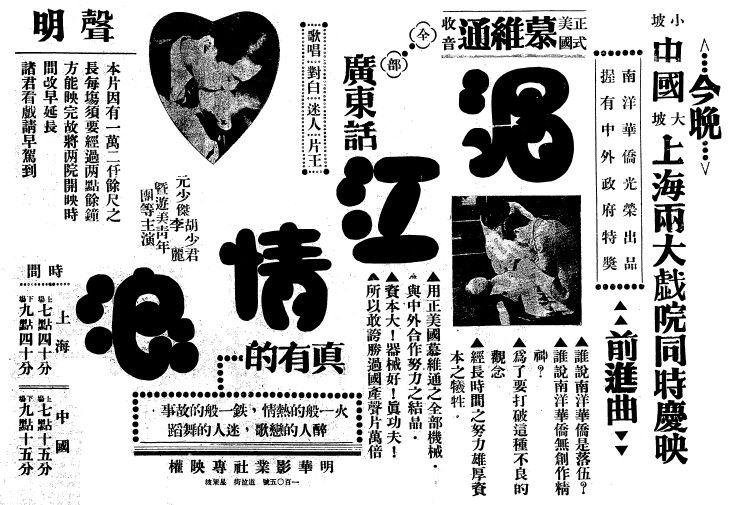
Abb.: Plakat,
Singapur, 1934
[Bildquelel: Wikipedia. -- Public domain]
|
"Romance in Mekong River(also known as "Honor Redeemed" or "Love Redeemed" in Hong Kong; Chinese: 湄江情浪) is a 1933 musical film made by a group of Chinese overseas in Bangkok formed "Siam United Film Studio", Thailand, directed by a USA Hollywood director with Western Electric Company's Movietone sound system in Cantonese dialect, film duration is 2 hours.[1] The film opened in Thailand cinemas on 10 October 1933;[2] opened in Hong Kong cinemas on 17 December 1933;[3] opened in Singapore cinemas on 8 December 1934.[4] Film Showing
A Chinese youth Cheung Hai Keung (Yuen Siu Kit 元少傑) married with a lustful wife Ng Chu Lau (Lee Lai 李麗), finally be divorced from her, she and her adulterer Lau Kwai Sung then slander Cheung Hai Keung as Chinese Communist, forcing him use a pseudonym as "Lee Cheung Seng(李章生)" escape to Bangkok, Thailand. When he arrive Bangkok, he was hurt by rice bags collapse beside "Tai Fung Rice Mill(大豐碾米廠)", so meet the boss Chan, get a job here, and fell in love with his daughter Chan Sik Fa (Wu Siu Kwan 胡少君).[5] Chinese Communist Party starts the civil war, Lau Kwai Sung to Bangkok too, but Cheung Hai Keung did not know he is evil, let him work together in "Tai Fung Rice Mill", so that let him a chance to cheat money and alienate their love! Accidentally, Ng Chu Lau escape to Bangkok too, everyone know the fact now, Cheung Hai Keung angrily shot her, and Lau Kwai Sung eat poison pill. Cheung Hai Keung get marry again with Chan Sik Fa. Film Theme HitsThree Cantonese film theme hits:
[Quelle: http://en.wikipedia.org/wiki/Romance_in_Mekong_River. -- Zugriff am 2013-03-17] |
1933-10-10

Bailey, britischer Konsul in Bangkok, an das Foreign Office:
"The King is mistaken In thinking that many foreigners hope that 'the King will make war upon Bangkok'.... All the foreigners want is a stable regime and as little taxation and interference with trade as possible) they would not much mind how this were brought about if only they were not discommoded in the process." [Zitiert in: Charivat Santaputra [จริย์วัฒน์ สันตะบุตร]: Thai foreign policy 1932-1946. -- Bangkok : Thai Khadi Research Institute, Thammasat University, 1985. -- 465 S. ; 21 cm. -- ISBN 974-335-091-8. -- S. 115]
1933-10-11 - 1933-10-23

Boworadet Revolte (กบฎบวรเดช)
Ergebnis auf Regierungsseite:
- 15 tote Soldaten
- 2 tote Polizeioffiziere
- 58 Verwundete
Über die Zahl der Opfer auf Seiten der Putschisten und Zivilisten liegen keine Angaben vor.
Abb.: Vickers Mark E Type B Leichtpanzer der siamesischen Armee währen der Boworadet Revolte (กบฎบวรเดช)
"The Boworadet Rebellion (Thai: กบฎบวรเดช; RTGS: Kabot Boworadet) was a Thai rebellion (or unsuccessful coup d'état) led by royalist Prince Boworadet (พลเอก พระวรวงศ์เธอ พระองค์เจ้าบวรเดช, 1877 - 1953) in 1933, in consequence of the conflicts between the previous royalist regime and the succeeding constitutional regime following the Revolution in 1932. The Boworadet revolt was eventually defeated by the Siamese Government. As a historical event it was cataclysmic in the transformation of Thai politics and government.
BackgroundIn March 1933, Pridi Phanomyong (ปรีดี พนมยงค์, 1900 - 1983), a Minister of State and a member of the People's Party (คณะราษฎร), was attacked verbally by the constitutional monarch King Prajadhipok (or King Rama VII, พระบาทสมเด็จพระปรมินทรมหาประชาธิปกฯ พระปกเกล้าเจ้าอยู่หัว, 1893 - 1941) as a communist following the proposal of the Draft National Economic Development Plan, or the Yellow Cover Dossier, to the National Assembly. The Yellow Paper was a plan to arrange and provide State welfare, to distribute all land to the rural poor, to interfere in economic affairs of the private sectors and to provide rural farmers more economic subsidies. These concepts were deemed communistic (or at least socialistic) by the Monarch. This led Thawan Ritthidet (Thai: ถวัลย์ ฤทธิเดช), a private citizen, to file a lawsuit against the King, accusing him of intervention in political, state and economic affairs. The fallout over Pridi's plan divided the Cabinet and led the Prime Minister, Phraya Manopakorn Nititada (พระยามโนปกรณ์นิติธาดา,, 1884 - 1948), to dissolve the National Assembly on the 1 April and use emergency decrees (such as the Anti-Communist Act) to govern. Pridi was immediately exiled to France.
On the 20 June, a senior Army Officer and member of the Khana Ratsadorn or the People's Party, General Phraya Phahon Phon Phayuhasena (Thai:พล เอก พระยาพหลพลพยุหเสนา (พจน์ พหลโยธิน), 1887 - 1947), seized power in a coup d'état, overthrowing the Government of Phraya Manopakorn. The coup leader appointed himself the second Prime Minister of Thailand, declared Pridi Phanomyong not guilty and allowed him to returned.
Prince Boworadet
Abb.: Prinz Boworadet (พลเอก พระวรวงศ์เธอ พระองค์เจ้าบวรเดช)
[Bildquelle: Wikipedia. -- Public domain]Prince Boworadet (Thai: พลเอก พระวรวงศ์เธอ พระองค์เจ้าบวรเดช, 1877 - 1953), a German-educated minor member of the Royal Family, had been Minister of Defense and the Siamese Ambassador to France. He lost his positions following the Revolution of 1932. An ardent royalist, he was furious that anyone was allowed to sue the King. This added to his discontent of Phraya Phahon Phon Phayuhasena's coup against Phraya Manopakorn and his support of Pridi against the monarch.
Prince Boworadej secretly plotted with Colonel Phraya Sri Sitthi Songkhram (Thai: พระยาศรีสิทธิ์สงคราม, 1891 - 1933), commander of the Armed Forces of Bangkok, and other senior military officers to stage a coup d'état to unseat the government and replace it with a more traditional one. When the Khana Ratsadon (คณะราษฎร - People's Party) took over, the older right-wing military officers had been unceremoniously pushed out and replaced by younger coup members.
On 11 October 1933, Prince Boworadet led royalist forces from the Eastern Region of the Country, consisting of the Korat (โคราช), Phetchaburi (เพชรบุรี), and Udon (อุดรธานี) Regiments, together with a cavalry unit and several artillery batteries. They reached the capital to find that the military units in Bangkok supported the government. He nevertheless continued the attempt.
Suppression of the Rebellion
Abb.: Regierungstruppen während der Rebellion
[Bildquelle: Wikipedia. -- Public domain]The first clash occurred on 11 October 1933 at Amphoe Pak Chong (ปากช่อง), in Nakhon Ratchasima Province (นครราชสีมา). The government forces were defeated and several members of the government were captured.
Abb.: Lage von Pak Chong (ปากช่อง)
[Bildquelle: OpenStreetMap. -- Creative Commons Lizenz (Namensnennung, share alike)]The rebels then marched to Bangkok's Khet Don Mueang (ดอนเมือง), calling themselves the National Rescue Council (Thai: คณะกู้บ้านเมือง; RTGS: Khana Ku Ban Mueang) and their attempt the Deer Plan (Thai: แผนล้อมกวาง; RTGS: Phaen Lom Kwang). Prince Boworadet tried to persuade other forces to join him, including the Royal Thai Navy, which instead declared itself neutral and sailed for bases in the South.
Abb.: Lage von Don Mueang (ดอนเมือง)
[Bildquelle: OpenStreetMap. -- Creative Commons Lizenz (Namensnennung, share alike)]
Abb.: Lieutenant Colonel Luang Phibulsonggram (แปลก พิบูลสงคราม)
[Bildquelle: Wikipedia. -- Public domain]The 'royal' government as it declared appointed Lieutenant Colonel Luang Phibulsonggram (แปลก พิบูลสงคราม, 1897 - 1964), one of the 1932 coup makers, to command the Bangkok forces. These were supported by an armoured car and a tank commanded by Pibun's friend, Lieutenant Colonel 'Luang Amnuai Songkhram (Thom Kesakomon) (Thai: หลวงอำนวยสงคราม (ถม เกษะโกมล)), who would later be killed in combat.
After a day of fierce fighting on 12 October, the rebels were able to capture Don Muang on the outskirts of the city. Major Luang Seri Somroeng Rit (Thai: พันตรีหลวงเสรีเริงฤทธิ์) was appointed (under truce) to ask the rebels to surrender, under a government offer of amnesty. However, the Major was seized and made a hostage. The rebels presented the following demands:
- the Country shall be headed by the King forever;
- all State affairs must be carried out in accordance with the Constitution, especially the appointment and removal of a member of the Council of Ministers, which can only be made by a majority of votes;
- Permanent public officials, both civil and military, shall not intervene in politics;
- The appointment of public officials shall be made with regard qualifications, without political partiality;
- The second type (non-elected) of the people's representatives shall be appointed by the King (as opposed to the Prime Minister);
- Armaments for the Army shall be provided everywhere, not gathered in any specific area;
- Amnesty shall be granted to the National Rescue Council and all its supporters.
The official 'Royal Siamese Government' in Bangkok refused to comply with the their demands, and the rebel forces advanced further to the capital, seizing the area around Bang Khen (บางเขน).
Abb.: Lage von Bang Khen (บางเขน) und Lak Si (หลักสี่)
[Bildquelle: OpenStreetMap. -- Creative Commons Lizenz (Namensnennung, share alike)]The rebels set up a stronghold near the Lak Si (หลักสี่) train station, using machine guns and cavalry. The government was able to drive the rebels with the help of the Nakhon Sawan (นครสวรรค์) Regiment and a declaration of the Prachinburi (ปราจีนบุรี) Regiment in support of the government and join the fight. This broke of the rebels' morale, and on 14 October they began to retreat. The next day the government with superior forces (heavy artillery having been moved in by rail) was able to attack the rebel stronghold. Running out of ammunition and supplies, the rebels broke. Government forces pursued and advanced to the rebel base in Nakhon Ratchasima (นครราชสีมา). On 23 October, with the possibility of further reinforcement by other provincial garrisons and the death in action of Boworadet's second-in-command, Phaya Sri Sitthi Songkram, the rebels were badly defeated. The remnants dispersed, and the revolt was over.
AftermathMuch destruction was done to the infrastructure of Bangkok (railways and bridges) and the surrounding area, including the Don Mueang Aerodome, from artillery bombardment, bombings and fire. On 25 October Prince Boworadet and his wife boarded an aeroplane and left Siam for Vietnam (then part of French Indochina). Many other leaders were arrested or surrendered, including Prince Boworadet's younger brother, Prince Sinthiphorn Kadakorn (Thai: หม่อมเจ้าสิทธิพร กฤดากร). The rest were eventually suppressed and were tried by a special court. Many received life sentences, but none were executed. Most sentences were later reduced and many were pardoned completely. Prince Boworadet received asylum in Cambodia, where he lived until 1948. He then returned home to Thailand, dying in 1953 at the age of 76.
LegacyAs the victorious faction Phraya Phahol's Government was able to further cement their grip on power, moving ever closer to a dictatorship using the military as a tool. Even though there is no evidence that Prajadhipok ever supported the rebellion, the result was nevertheless a blow to the King, as his prestige was greatly diminished and his power severely weakened. The King's lack of leadership and indecisiveness showed when he only released a telegram saying that he regretted the strife and civil disturbances that occurred, he and the Queen then left the capital for Songkhla (สงขลา) leaving the Government to deal with the rebellion. During this time he also failed to support his constitutional Government morally, which undermined his credibility and his perceived commitment to democracy and the constitutional system. This gave Phraya Phahol and the King's opponents reason to point that the monarch has failed to do his duty. The series of events following the rebellion eventually led to the King's abdication in 1935. The rebellion also led to the estrangement of the aristocratic factions and families, which has served the Kingdom for centuries. They were viewed with distrust and would never again regained their power and position in Thai politics.
The rebellion was also seen as a beginning of the meteoric rise of the two key players in the rebellion: Pridi and Phibul. Pridi, eventually became leader of the civilian faction within the Government and later Regent for King Ananda Mahidol (or Rama VIII) from 1944–1946 and then eventually Prime Minister in 1946. Phibul became the new leader and hero of the military faction and replacing Phraya Phahol as Prime Minister from 1938–1944 and then later 1948–1957, and eventually de facto dictator of Thailand (to date the longest serving Prime Minister in Thai history).
The Rebellion Suppression Monument was established at Khet Lak Si, Bangkok, as a commemoration of this event, and later renamed as the Constitution Defense Monument."
Abb.: Rebellion Suppression Monument / Constitution Defense Monument (อนุสาวรีย์พิทักษ์รัฐธรรมนูญ), 2008
[Bildquelle: 2T / th.Wikipedia. -- GNU FDLicense][Quelle: http://en.wikipedia.org/wiki/Boworadet_Rebellion. -- Zugriff am 2013-04-28]
"Diese Boworadet-Revolte war übrigens auch nicht spurlos an der Bevölkerung vorübergegangen. Im Jahre 1933/34 streute ein Mann in der Gegend von Mahasarakam [มหาสารคาม] das Gerücht aus, Prinz Boworadet habe die Weißen zur Beseitigung der ungerechten Herrschaft von Phya Phahon Phonphayuhasena [พระยาพหลพลพยุหเสนา, 1887 - 1947] und Pridi Phanomyong [ปรีดี พนมยงค์, 1900 - 1983] ins Land geholt. Diese beiden Politiker wurden in diesem Gerücht beschuldigt, das Volk durch zu hohe Steuerabgaben ins Unglück gestürzt und die Konfiszierung von Besitz der Bevölkerung geplant zu haben. Die von Boworadet zu Hilfe gerufenen Weißen hätten Phya Phahon und Pridi festgenommen und enthauptet. Verbindungen zur Boworadet-Revolte waren auch im Zusammenhang mit der Inhaftierung eines Novizen festgestellt worden, der 1934 die Bevölkerung glauben machte, er besitze übernatürliche Kräfte. In seinem Besitz waren auch ein Portrait von Prinz Boworadet und "some important documents" gefunden worden." [Quelle: Skrobanek, Walter <1941 - 2006>: Buddhistische Politik in Thailand : mit besonderer Berücksichtigung des heterodoxen Messianismus. -- Wiesbaden : Steiner, 1976. -- 315 S. ; 24 cm. -- (Beiträge zur Südasienforschung ; 23). -- ISBN 3-515-02390-9. -- Zugl.: Heidelberg, Univ., Diss., 1972. -- S. 68. -- Mit Erlaubnis des inzwischen verstorbenen Autors]
Abb.: Lage von Mahasarakham [มหาสารคาม]
[Bildquelle: OpenStreetMap. -- Creative Commons Lizenz (Namensnennung, share alike)]

Telegramm des Königs aus Hua Hin (หัวหิน) an Colonel Phya Phahon Phonphayuhasena (พลเอก พระยา พหลพลพยุหเสนา, 1889-1958):
"That Prince Bovoradet contemplates disturbing the peace is contrary to His Majesty’s wishes for he is constantly warning members of the royal family not to do so. But when there is somebody not heeding his wishes in this matter, His Majesty can only regret it.." [Zitiert in: Stowe, Judith A. <1934 - 2007>: Siam becomes Thailand : a story of intrigue. -- Honolulu : Univ. of Hawaii Pr., 1991. -- 394 S. : Ill. ; 22 cm. -- ISBN 0-8248-1394-4. -- S. 63]

Japan gratuliert Siam als erste Nation zur Niederschlagung der Revolte.


Frankreich und Großbroitannien gewähren Putschisten Asyl.
1933-10-11
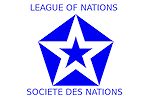
Der Völkerbund verabschiedet die International Convention for the Suppression of the Traffic in Women of Full Age. Siam unterzeichnet nicht.
Der Völkerbund rechnet Siam zu den Zielländern für arme Mädchen und Frauen. Schätzungsweise 2000 bis 3000 Frauen und Mädchen werden jedes Jahr nach Siam als Prostituierte gebracht. Sie arbeiten in Bordellen, die hauptsächlich von Chinesen betrieben werden. Von den 151 registrierten Bordellen in Bangkok, haben 126 chinesische Eigentümer.
1933-10-17

Die Federated Malay States erheben Einfurzölle für Reis. Da 29% der Reisexporte Siams in die Federatet States gehen, verschlechtert sich dadurch der siamesische Markt für Reis.
1933-10-19
Bangkok Times Weekly Mail zur strikten Pressezensur:
"His Majesty's Government wishes to make it known that it is preferable to possess a silent tongue." [Zitiert in: Stowe, Judith A. <1934 - 2007>: Siam becomes Thailand : a story of intrigue. -- Honolulu : Univ. of Hawaii Pr., 1991. -- 394 S. : Ill. ; 22 cm. -- ISBN 0-8248-1394-4. -- S. 66]
1933-10-25
Als Reaktion gegen die Bowaradet-Revolte spendet Prinz Chula Chakrabongse (จุลจักรพงษ์, 1908 – 1963) der Regierung 5.000 Baht.
1933-10-30

Communique 55 der Regierung: zur Niederschlagung der Boworadet Revolte (กบฎบวรเดช)
"Due to the merit of His Majesty, coupled with the divine assistance of the Gods protecting the Kingdom and that of the Emerald Buddha [พระแก้วมรกต], the Government troops were able to defeat the opposing forces and drive them back to Korat [โคราช]." [Zitiert in: Skrobanek, Walter <1941 - 2006>: Buddhistische Politik in Thailand : mit besonderer Berücksichtigung des heterodoxen Messianismus. -- Wiesbaden : Steiner, 1976. -- 315 S. ; 24 cm. -- (Beiträge zur Südasienforschung ; 23). -- ISBN 3-515-02390-9. -- Zugl.: Heidelberg, Univ., Diss., 1972. -- S. 209. -- Mit Erlaubnis des inzwischen verstorbenen Autors]
1933-10-30
Act for the Protection of the Constitution: wer die Verfassung in Frage stellt, wird mit Gefängnis bis zu 20 Jahren bestraft.
1933-10-30

G. W. Harrison, Beamter des britischen Foreign Office, zur Boworadet Revolte (กบฎบวรเดช):
"The European communities are in favour of the rebels or royalists but they do not, as yet, show signs of uneasiness." [Zitiert in: Charivat Santaputra [จริย์วัฒน์ สันตะบุตร]: Thai foreign policy 1932-1946. -- Bangkok : Thai Khadi Research Institute, Thammasat University, 1985. -- 465 S. ; 21 cm. -- ISBN 974-335-091-8. -- S. 115]
1933-11-02
Der Bergbauingenieur J. Davis veröffentlicht eien Abhandlung über große Ölschiefervorkommen in Siam. Sie könnten Siams Bedarf an Erdöl decken, falls die Erdölpreise so steigen, dass die Gewinnung des Erdöls aus dem Ölschiefer rentabel wird.
1933-11-08

Geburtstag des Königs. Der König ist bei den schlichten Feiern in Bangkok nicht anwesend. Es liegt nur ein Glückwunschbuch aus.
1933-11-09


Bericht der deutschen Gesandtschaft an das Auswärtige Amt
"Hinsichtlich der deutschen Sprachkurse [durch die siamesisch-deutsche Vereinigung] für Siamesen ließ es sich die deutsche Gesandtschaft nicht nehmen, in ihrem Bericht zu bemerken, dass vom allgemeinen deutschen Standpunkt aus nur zu begrüßen wäre, wenn sie sich der Beliebtheit der Siamesen weiterhin erfreuen dürften. „Sollten sich auch nur die Sprachkurse durchsetzen, so wäre damit ein deutsches Gegenstück zu der von der hiesigen Alliance Française seit Jahren mit Unterstützung der Französischen Regierung betriebenen französischen Sprachpropaganda geschaffen"
Aufgrund der nicht geringen Bedeutung der deutschen Sprachkurse und der bereits erwähnten Ziele der siamesischdeutschen Vereinigung bat die deutsche Gesandtschaft das Auswärtige Amt, es möge der Vereinigung einen jährlichen Zuschuss von mindesten 800 Reichsmark gewähren.
Warum der Vereinigung diese gestattet werden sollte, erklärte der neue Geschäftsführer, Herr Götte, noch wie folgt:
„Wir verfolgen wiederum das Ziel, sie (die Siamesen) zum Verständnis der deutschen Kultur und Geschichte zu erziehen, sie möglichst eng an uns heranzuziehen und sie auf diesem Wege als Werberzellen unter ihren Landsleuten zu gewinnen und zu erhalten. Unter diesen Gesichtspunkten sind die Ziele der Vereinigung als streng national zu bezeichnen und verdienen die Förderung aller, die nur etwas für sie tun können. Die Siamesisch-Deutsche Vereinigung beabsichtigt auch ihre siamesischen Freunde mit dem neuen Deutschland bekannt zu machen, welche Aufgabe in unauffälliger und den Umständen angemessener Weise durchgeführt werden soll"."
[Quelle: Catthiyakorn Sasitharamas [คัททิยากร ศศิธรามาส]: Die deutsch-thailändischen Beziehungen in der Zeit der Weimarer Republik bis zum Ende des Zweiten Weltkriegs. -- Hamburg : Kovač, 2012. -- 346 S. ; 21 cm. -- (Schriftenreihe Schriften zur Geschichtsforschung des 20. Jahrhunderts ; Bd. 4). -- ISBN 978-3-8300-6361-2. -- Zugl.: Hamburg, Univ., Diss., 2012. -- S. 291f. -- Fair use]
1933-11-13

Tod des Islam-Gelehrten Muhammad Yusuf bin Ahmad, genannt Tok Kenali (geboren 1868) von Patani (كراجأن ڤتتاني)
Abb.: Einbandtitel
1933-11-15

Wahlen von 78 Abgeordneten (die gleiche Anzahl wird vom König ernannt)
"General elections were held in Siam on 15 November 1933. At the time there were no political parties,[1] so all candidates ran as independents. Voter turnout was 41.5%.[2] Results
Party Votes % Seats Independents 100 Invalid/blank votes - - Total 1,773,532 100 Source: Nohlen et al References
- Nohlen, D, Grotz, F & Hartmann, C (2001) Elections in Asia: A data handbook, Volume II, p284 ISBN 0199249598
- Nohlen, D, Grotz, F & Hartmann, C (2001) Elections in Asia: A data handbook, Volume II, p278 ISBN 0199249598"
[Quelle: http://en.wikipedia.org/wiki/Siamese_general_election,_1933. -- Zugriff am 2011-11-04]
Gewählte Abgeordnete u.a.:
- 18 pensionierte kleine Beamte
- 15 Rechtsanwälte
- 8 pensionierte hohe Beamte
- 3 für den Putsch 1912 verurteilte Revolutionäre
- 2 Lehrer
Vom König ernannte Abgeordnete u.a.:
- 19 Funktionäre
- 49 Militärs (5 von der marine)
Kommentare zum Wahlsystem und zur Wahl:
"The technique of the elections was simple. Candidates and electors met on the day and hour fixed in an entertainment hall or temple lent for the occasion. Each candidate was allowed fifteen minutes in which to outline his program. Like any Western politician, he promised the usual array of desirable public works for his constituents and a reduction in taxation and followed this up with the customary attack on his opponent. Many of the candidates spoke too fast to be understood or put on vaudeville stunts. After a reasonable time had elapsed for discussion among the voters and for questions to be put to the candidates, the vote was taken. When the results were announced, a garland of flowers was placed around the victor’s neck. All this took place in an atmosphere of calm amiability bordering on indifference." [Quelle: Thompson, Virgina <1903 - 1990>: Thailand the new Siam. -- New York : Macmillan, 1941. -- 865 S. : 24 cm. -- S. 83]
"Barring unconstitutional seizure of power, the Government party is assured of a majority in the Assembly for ten years. First of all, we have the temporary provisions of the Constitution under which half the members of the Assembly will be appointed by His Majesty the King, who will not depart from the recommendations of His Ministers.
Then we have the Election Law, the working of which will be found to lend itself very readily to a managed election. Under its provisions no private candidate can make his appeal direct to the electors because they do not directly elect him. The people may want to have some particular man as their representative in the Assembly, but they will have no means of carrying out their will. Under this system nobody has any chance except the Government’s candidate.
If the next Assembly, therefore, has more than ten members sitting on the opposition bench, it will be a miracle."
[Daily Mail. -- 1933-07-29. -- Zitiert in Landon (1939), S. 35f.]
"Democratic government in Siam has begun to experience one of the checks that observers have expected as from day to day now, they watch the returns from the polling booths as the people of Bangkok vote for their Tambol (ตำบล)) representatives. The "check" is the general apathy on the part of the people toward the whole matter of who holds office or what the candidate stands for in policy. It is certainly not a surprising development to people familiar with the mass of people on whom this right of franchise has suddenly been thrust. One of the things that the Government has to remember continually is that the people who, for the most part, cannot read or write, such as more than 95 per cent of the electorate in Siam, are not likely to go to the polls to vote, either now or for many years to come. Only education, which brings with it a consciousness of national and, in the long run, international affairs, will awaken the majority of the people in Siam to their duties at the polls."
[Daily Mail. -- 1933-10-04. -- Zitiert in Landon (1939), S. 36.]
"In Tambol Nagor Jaisri (Nakhon Chaisi - นครชัยศรี) only 834 out of a possible 5,092 votes were cast for 22 candidates. In Tambol Talat Phlu (ตลาดพลู) only 42 votes out of a possible 4,000 were cast for two candidates.
In Tambol Ban Kaek (บ้านแขก) 106 votes of a possible 1,366 were cast for three candidates.
Some people voted simply for the novelty of it, dropping their votes into the first box available without knowing for whom they were voting. Many of the Tambols (ตำบล) had no candidate at all and so had no voice in the actual election of representatives to the assembly."
[Landon (1939), S. 36]
1933-11-16


Die USA anerkennen die Sowjetunion und nehmen zu ihr diplomatische Beziehungen auf.
1933-12
Bahnüberfall mit Raub von 300.000 Baht. Die Räuber werden gefasst
1933-12

"Towards the end of 1933. King Prajadhipok's relationship with the government worsened. The King wished to go abroad, ostensibly for an eye operation. The government feared that, being abroad, the King might have a good platform to negotiate terms with the government, and ultimately he could abdicate, never to return. Japan did not lose this opportunity to gain more favour. Under instruction from Tokyo, the Chargé d' Affaires, Mr. Miyazahi Shinro [進路宮崎 ?], approached Pahol "in great secrecy." He suggested a Japanese eye specialist to come to Siam to look after the King, but he was told that the King had his mind made up. After more telegrams, Miyazahi asked Prince Devavong [เทวะวงศ์] to send the King to Japan. The offer was politely dedined on the grounds that the King "had no desire to convalesce in Japan"." [Quelle: Charivat Santaputra [จริย์วัฒน์ สันตะบุตร]: Thai foreign policy 1932-1946. -- Bangkok : Thai Khadi Research Institute, Thammasat University, 1985. -- 465 S. ; 21 cm. -- ISBN 974-335-091-8. -- S. 119]
1933-12

Frankreich weigert sich, Prinz Boworadet (พลเอก พระวรวงศ์เธอ พระองค์เจ้าบวรเดช, 1877 - 1953), der in Französisch-Indochina im Exil lebt, als Kriminellen an Siam auszuliefern.
1933-12-09
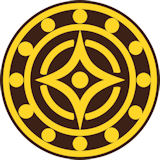

Tod von Dara Rasmi (ดารารัศมี), Prinzessin von Chiang Mai (เชียงใหม่) (1873 - 1933)
Abb.: Dara Rasmi (ดารารัศมี), Prinzessin von Chiang Mai (เชียงใหม่)
[Bildquelle: Wikipedia. -- Public domain]
Abb.: Dara Rasmi (ดารารัศมี), Prinzessin von Chiang Mai (เชียงใหม่)
[Bildquelle: Wikipedia. -- Public domain]
"Princess Dara Rasmi (RTGS: —Dara Ratsami—; Thai: ดารารัศมี), (August 26, 1873 – December 9, 1933), was the Princess of Chiang Mai (เชียงใหม่ / ᨩ᩠ᨿᨦᩉ᩠ᨾᩲ᩵) and Siam (later Thailand) and the daughter of King Inthawichayanon (พระเจ้าอินทวิชยานนท์, gest. 1897) and Queen Thipkraisorn Rajadevi (แม่เจ้าเทพไกรสร) of Chiang Mai descended from the Jedton Dynasty (เชื้อเจ็ดตน). She was one of the princess consorts of Chulalongkorn, King Rama V of Siam and gave birth to one daughter by King Chulalongkorn, Princess Vimolnaka Nabisi (พระเจ้าบรมวงศ์เธอ พระองค์เจ้าวิมลนาคนพีสี, 1889 - 1892). Early life
Princess Dara Rasami of Chiang Mai was born on 26 August 1873 at Khum Luang (คุ้มหลวง) in Chiang Mai, Northern Siam, the daughter of King Inthawichayanon and Queen Thipkraisorn Rajadevi of Chiang Mai. Her mother was the daughter of King Kawilorot (พระเจ้ากาวิโลรสสุริยวงศ์) and Queen Usa (แม่เจ้าอุษาราชเทวี). Princess Dara Rasmi had one elder sister, Princess Chantra Sopha of Chiang Mai who died as a young child.
As a young girl, Dara Rasami was taught proficiency in the Thai, Lan na (ᩃ᩶ᩣ᩠ᨶᨶᩣ), and English languages as well as the traditional royal customs of both Lan Na and Siam. Her favorite sport was horseriding, and later in her life she was said to be a skilled horsewoman.
To the royal palaceAs the British encroached further and further into Burma in the 1860s and '70s, Siam became concerned that England wanted to annex the Kingdom of Chiang Mai (later northern Thailand). In 1883 a rumor spread that Queen Victoria wanted to adopt Princess Dara Rasami of Chiang Mai, which the Siamese saw as a British attempt to take over Lanna. King Chulalongkorn then sent his brother Prince Phicit Prichakorn to Chiang Mai to propose an engagement to Dara Rasami to become the king's concubine. In 1886, she left Chiang Mai to enter the Grand Palace in Bangkok, where she was given the title Chao Chom Dara Rasami of the Chakri Dynasty.
Life in the Grand PalaceWhen Dara Rasami arrived at the Grand Palace her father sent money from Chiang Mai to King Chulalongkorn to build a new house for her. While she lived in the Grand Palace, Dara Rasami and the ladies in her entourage were ribbed and called "Lao ladies," as well as teased that they "smelled of fermented fish." Despite these difficulties, Dara Rasami and her entourage always wore Chiang Mai style textiles for their skirts (known as pha sin - ผ้าซิ่น) with their long hair pulled up into a bun on the back of the head, in contrast to the clothing and hairstyles of the Siamese women.
She gave birth to King Chulalongkorn's daughter, Princess Vimolnaka Nabisi, on 2 October 1889, whereupon the king promoted her to Chao Chom Manda Dara Rasami from Chao Chom. However, when her daughter was only two years, eight months old, she became ill and died on 21 February 1892. Her death brought sadness to the King, and the royal families of both the Siamese and Chiang Mai kingdoms. Princess Dara Rasami was so distraught after her only daughter's death, that she destroyed all photos and portraits of her as well as those of her husband and daughter together. The child's ashes were divided in half, with one part kept with her mother's ashes in the Chiang Mai Royal Cemetery at Wat Suan Dok (วัดสวนดอก), and the other in the Royal Women's Cemetery, Wat Ratchabophit (วัดราชบพิธสถิตมหาสีมารามราชวรวิหาร), Bangkok.
Promotion to Princess ConsortOn 12 February 1908, King Chulalongkorn promoted Chao Chom Manda Dara Rasmi to Princess Consort Dara Rasmi or Phra Rajchaya Chao Dara Rasmi, in the first such promotion ever. Her title as fifth consort equated to those of the other four Thai consorts Saovabha, Savang Vadhana, Sukhumala Marasri and Saisavalibhirom.
Return to Chiang MaiFrom the time she became Princess Consort in 1886, Dara Rasami never returned to Chiang Mai, even after her father, King Inthawichayanon of Chiang Mai died in 1897. In 1908, King Intavaroros Suriyavongse of Chiang Mai, who was her half brother, came to Bangkok and visited King Chulalongkorn. At that time, Princess Dara Rasami asked for permission from King Chulalongkorn to visit her relatives in Chiang Mai, which he granted.
However, King Chulalongkorn was concerned for her safety on the long journey. On 2 February 1908, the King along with the royal family, officials of the department and senior government officials, came to send her off by train at Samsen (สามเสน) train station. The King ordered his brother, Prince Damrong Rajanubhab (สมเด็จพระเจ้าบรมวงศ์เธอ พระองค์เจ้าดิศวรกุมาร กรมพระยาดำรงราชานุภาพ, 1862 - 1943) and Prince Dilok Nopharat (พระองค์เจ้าชายดิลกนพรัฐ, 1884 - 1912, son of King Chulalongkorn and Princess Thipkesorn of Chiang Mai - เจ้าจอมมารดาเจ้าทิพเกษร ณ เชียงใหม่) to meet Princess Dara Rasami at Nakorn Sawan (นครสวรรค์) from where she traveled to Chiang Mai by boat.
At that time, transportation was very slow and it took Dara Rasami two months and nine days to travel to Chiang Mai, where she arrived on 9 April 1909. Chao Phraya Surasri Wisitsak, the governor general of northwest territory, the royal family of Chiang Mai, soldiers and people from all over Lan Na came to celebrate her arrival.
While in Chiang Mai, Dara Rasami visited her relatives in Lamphun (ลำพูน) and Lampang (ลำปาง) as well as the people in Lan Na. She and King Chulalongkorn corresponded regularly via many affectionate letters throughout the time she was away from Bangkok.
Princess Dara Rasami returned to Bangkok after about six months. Upon her return, the King and the royal family, government officials and people came to receive her with 100 royal boats at Ang Thong (อ่างทอง ). From there, she and the King went to Bang Pa-In Royal Palace (พระราชวังบางปะอิน), where they stayed for two days before returning to Bangkok on 26 November 1909.
Death of King ChulalongkornAfter Dara Rasami came back to Bangkok, she moved into a new house, Suan Farang Kangsai, which the King had built for her next to Vimanmek Palace while she was away. Only a year later, however, her husband died on 23 October 1910 of kidney disease at Dusit Palace.
Following his death, Dara Rasami continued to live in Dusit Palace until 1914, when she asked for permission from King Vajiravudh to return to Chiang Mai to retire. The King granted her permission, and she returned Chiang Mai on 22 January 1914.
Later life and deathPrincess Dara Rasami continued with her royal duties for the people of Lanna. In later life, she lived in Daraphirom Palace that King Vajiravudh built for her and her official attendants. On 30 June 1933, an old lung ailment recurred. Both western and Thai doctors tried to cure her, but no one succeeded. Her half brother, Chao Keo Naovarat (เจ้าแก้วนวรัฐ) moved her into his palace at Khum Rin Keaw for treatment, but on 9 December 1933, she died there peacefully at the age of 60."
[Quelle: http://en.wikipedia.org/wiki/Dara_Rasmi. -- Zugriff am 2012-04-04]
1933-12-11
Die beiden Abgeordneten von Chiang Mai (เชียงใหม่) werden mit einer traditionellen Elefantenprozession zum Bahnhof geleitet, wo sie den Zug nach bangkok besteigen, um ihre Sitze im Abgeordnetenhaus einzunehmen.
1933-12-16 - 1934-09-22

5. Kabinett: Pahon (พหลโยธิน) II
1933-12-20


Empfang des Königs zum Geburtstag der Königin Rambhai Barni (สมเด็จพระนางเจ้ารำไพพรรณี พระบรมราชินี, 1904 - 1984)
Abb.: Königin Rambhai Barni (สมเด็จพระนางเจ้ารำไพพรรณี พระบรมราชินี), 1934
[Bildquelle: Wikimedia. -- Public domain]
"Laut Nord [Erich August Karl Nord, 1881 - 1935, deutscher Gesandter] war König Prajadhipok im Dezember 1933 in Bangkok anwesend und ließ am 20. Dezember 1933 aus Anlass des Geburtstags der Königin mit Beteiligung des diplomatischen Korps einen Nachmittagsempfang veranstalten. Nach diesem Empfang lud der König das diplomatische Korps erneut zu sich, diesmal zu dem oben erwähnten Abendessen, an dem Gesandter Nord ebenfalls teilnahm. Betreffend Deutschland äußerte sich der König nach dem Essen, dass er sich für die dortige Situation interessiere. König Prajadhipok bemerkte sogar, dass er das Buch des Reichskanzlers Hitler „Mein Kampf" in englischer Übersetzung gelesen habe [welche angebliche Übersetzung der König damit meint, kann nicht nachgewiesen werden], von dem er allerdings annähme, dass einige Teile in verkürzter Form wiedergegeben wären. Der König erzählte ebenfalls, dass er außerdem noch eine englische Abhandlung über den Nationalsozialismus gelesen habe, die ihm objektiv zu sein scheine. Ferner brachte König Prajadhipok seine Hoffnung zum Ausdruck, dass er bei seinem geplanten Besuch in Deutschland Gelegenheit haben werde, mit Reichspräsidenten [Paul Ludwig Hans Anton von Beneckendorff und] von Hindenburg [1847 - 1934] und Reichskanzler Hitler [1889 - 1945] persönlich zu verkehren. Dabei äußerte er seine Befürchtung, dass die Verständigung zwischen ihnen durch seine mangelnde Deutschkenntnisse erschwert würde. So erwiderte Nord dem König, dass man im Auswärtigen Amt in ausreichendem Umfang Dolmetscher habe, so dass das Gespräch so gut auf Englisch wie auf Französisch - die Sprachen, die König Prajadhipok gleichermaßen fließend beherrschte - geführt werden könne.
Weiterhin vermittelte Nord in seinem Bericht, dass zu diesem Zeitpunkt der Premierminister, Phraya Phahol [Phonphayuhasena - พลเอก พระยาพหล พลพยุหเสนา, 1887 – 1947], in das Gespräch zwischen ihm und dem König eingriff und erzählte, dass er den Ministerpräsidenten [Hermann] Göring [1893 - 1946] von der Kadettenschule her gut kenne. So fragte der König Phraya Phahol nach den Einzelheiten und danach die Auffassung äußerte, es sei doch höchst eigenartig, dass zwei Kadetten, die gemeinsam eine Schulbank gedrückt hätten, fast gleichzeitig zu wichtiger Position in so verschiedenen Ländern aufgestiegen seien. Dann beendete der König das Gespräch, indem er seine Gäste aufgeforderte, der Vorführung aus der Rāmāyana-Sage im königlichen Theater beizuwohnen.
Doch neben Premierminister Phraya Phahol kannte laut eines Buchs von Sònsan Phaengsapha, „die thailändischen Kadetten und Offiziere in der Kaiserzeit Deutschlands" [สรศัลย์ แพ่งสภา <1920 - 2009>: นักเรียนนายร้อยไทยในเยอรมันยุคไกเซอร์. -- กรุงเทพฯ : พี. วาทิน พับลิเคชั่น, 2549 [= 2006]. -- 198 S. : Ill. ; 21 cm -- ISBN 9789744842091], eine Reihe berühmter Persönlichkeiten Siams Göring. Die damals genannten
- Prinz Nil (der spätere Generalleutnant Mòmchao Nillapraphat Kasemsri [เกษมศรี]),
- Prinz Tri (der spätere Generalleutnant Mòmchao Tritiphetphong Thewakul [เทวกุล]),
- Nay Nòm (der spätere Generalleutnant Phra Sakdaphonlarak [พระ ศักดาพลรักษ์]),
- Nay Chit (der spätere Oberstleutnant Phraya Suradetronnachit [พระยา สุรเดชรณชิต]),
- Nay Charoen (der spätere Oberstleutnant Phraya Sriphichaisongkhram [พระยา ศรีพิชัยสงคราม]),
- Nay Sa-ad (der spätere Oberstleutnant Phra Insònsan),
- Nay Din [นาย ดิ่น] (der spätere Oberstleutnant Phraya Srisitthisongkhram [พระยา ศรีสิทธิสงคราม, 1891 - 1933]) sowie
- Nay Thep [นาย เทพ] (der spätere Oberstleutnant Phraya Songsuradet [พระยา ทรงสุรเดช, 1891/92 - 1944]),
wurden zur selben Zeit wie Göring - etwa von 1908 bis 1910 - in der Hauptkadettenanstalt in Lichterfelde bei Berlin ausgebildet. Als die genannten Kadetten nach Beendigung ihres Studiums wieder in ihrem Heimatland waren, gelang es ihnen, wichtige militärische Posten zu bekleiden, wobei sie bereit waren, an die engen Kontakte mit Deutschland wieder anzuknüpfen und sie weiterzupflegen."
[Quelle: Catthiyakorn Sasitharamas [คัททิยากร ศศิธรามาส]: Die deutsch-thailändischen Beziehungen in der Zeit der Weimarer Republik bis zum Ende des Zweiten Weltkriegs. -- Hamburg : Kovač, 2012. -- 346 S. ; 21 cm. -- (Schriftenreihe Schriften zur Geschichtsforschung des 20. Jahrhunderts ; Bd. 4). -- ISBN 978-3-8300-6361-2. -- Zugl.: Hamburg, Univ., Diss., 2012. -- S. 208ff. -- Fair use]
Abb.: Hermann Göring, 1907
[Bildquelle: Bundesarchiv, Bild 183-R25668 / CC-BY-SA 3.0]
1933-12-29

US-Ingenieur Edwin Howard Armstrong (1890 - 1954) erhält das Patent auf die technische Verwirklichung von Frequenzmodulation (FM). Diese ist weit weniger anfällig für Störungen bei der Rundfunkübertragung als die bis dahin alleinige Amplitudenmodulation (AM).
Abb.: Gegenüberstellung von Amplituden- und Frequenzmodulation
[Quelle des animated gif: Berserkerus / Wikimedia. -- Creative Commons Lizenz (Namensnennung, share alike)]
1934-01
Der Abgeordnete Dong Indra (ทองอินทร์ ภูริพัฒน์, 1906 - 1949) kritisiert die Regierung dafür, dass sie immer mehr zivile Staatsposten mit Militärs besetzt. Das schaffe nicht nur Unzufriedenheit bei den Beamten, sondern werde auch vom Volk als ungerecht empfunden. Der Ministerpräsident antwortet, dies sei nur eine Sparmaßnahme, indem Militärpersonal an andere Resorts ausgeliehen werde.
Abb.: Dong Indra (ทองอินทร์ ภูริพัฒน์)
[Bildquelle: th.wikipedia. -- Public domain]
1934-01

Empfehlungen des japanischen Kriegsministers Sadao Araki (荒木 貞夫, 1877 – 1966) an Ministerpräsident Saitō Makoto (斎藤 実, 1858 - 1936)
- "Direct publishing activities so that they contribute to state prosperity, social order, the smooth functioning of national life and to wholesome public entertainment"
- "Ban views which would impair fundamental national policies"
- "Tighten controls over rumors, gossip, speech, and publications that would harm the state. "
- "Tighten controls over subversive organizations. The most severe methods should be employed against Communist or treasonous activities carried out by legal groups which disseminate antiwar and antiimperialist ideas. The populace should understand the danger, oppose these subversive movements, and support their dissolution"
- "Strengthen public unity for national mobilization by making participation in the Reservists’ Association and youth training mandatory and by encouraging organizations such as the Youth Association, Boy Scouts, Patriotic Women’s Association, National Defense Women’s Association, Red Cross Society, Harmonization Society, Medical Relief Society, Soldiers’ Support Association and religious, social welfare and spiritual associations. "
[Übersetzung: Ienaga, Saburō [家永三郎] <1913 - 2002>: The Pacific War : World War II and the Japanese, 1931-1945. -- New York : Pantheon, 1978. -- ISBN 0394497627. -- Originaltitel: 太平洋戦争 (1968). -- S.98. -- Fair use]
1934-01-03

Chankhet Chatraphut [จันทร์เกตุ] fordert die Zwangsvereinigung von Mahanikaya [มหานิกาย] und Thammayutika-Nikaya [ธรรมยุติกนิกาย]:
"Dieses Argument [von der Verfassung garantierte Religionsfreiheit wurde denn auch vom Thammayutika-Nikaya [ธรรมยุติกนิกาย] ins Feld geführt, als die Öffentlichkeit und politisierte Mönche des Mahanikaya [มหานิกาย] die Forderung nach Zwangsvereinigung mit der Konsequenz der Majorisierung des kleineren Thammayutika-Nikaya erhoben. Direkten Anlass dazu gaben schon relativ kurze Zeit nach dem Coup d'Etat zwei Petitionen auf Vereinigung der beiden Nikayas [นิกาย], die von Laien an den Premierminister gerichtet waren und von diesem an die Führer des buddhistischen Ordens weitergeleitet wurden. Ein gewisser Chankhet Chatraphut aus Siracha [ศรีราชา] schrieb am 3. Januar 1934, dass die Einheit des Volkes aufgrund der Existenz zweier Nikayas verloren gegangen sei.
Zur Prozedur der Verschmelzung schlug er eine Abstimmung im buddhistischen Orden vor, deren Ergebnis darüber entscheiden solle, nach den Grundsätzen welcher Nikaya künftig der einheitliche buddhistische Orden ausgerichtet sein solle.
Außerdem forderte er die Abschaffung der "Klassen" innerhalb des Ordens sowie die Beseitigung des "Samanasak" [สมณศักดิ - vom König vergebene Titel für Mönche]. Lediglich das System der "Parian"-Ränge [เปรียญ] sollte bestehen bleiben, d.h. ein Rangsystem, das sich an der Ablegung bestimmter akademischer Prüfungen orientiert, wie dies auch durch den Titel "Maha" [มหา] für Mönche gekennzeichnet wird.
Weiterhin wird eine strikte Einhaltung der Vinaya-Regeln, besonders das Verbot des Betel-Kauens und des Zigaretten-Rauchens, gewünscht. Schließlich solle der Sonntag als gesetzlicher Feiertag wieder abgeschafft und durch den buddhistischen Feiertag "Wan Phra" [วันพระ] ersetzt werden.
Die hohe Ordens-Verwaltung [มหาเถรสมาคม], die stark mit Mönchen des Thammayutika- Nikaya besetzt war, konnte sich mit einigem Recht bei der Stellungnahme zu Forderungen dieser Art auf die Verfassung berufen. Phra Phutthakhosachan [สมเด็จพระพุทธ โฆษาจารย์, 1872 - 1951], der stellvertretende Patriarch des buddhistischen Ordens, erwiderte auf den Vorwurf, dass zwei Nikayas die Einheit der Nation behinderten, folgendes:
"Religiosität. Geistesbildung und die Stärkung des Guten sind ein wertvoller Besitz und fördern das Glück. Was die spezifischen Bedürfnisse der Bürger betrifft, d.h. an welche Religion man glaubt und wie man sie praktiziert, so stellen sie solange keine Gefahr für das Volk dar, solange sie dem Glück dienen. Deshalb sind sie auch besser als Religionslosigkeit. Deshalb gewähren die Verfassungen vieler Länder, einschließlich Siams, Freiheit in religiösen Fragen und im Kultus, die ja nicht den Pflichten des Bürgers widersprechen.
Außerdem ist die Existenz von Mönchen mehrerer Nikayas kein Grund für eine Spaltung der Einheit. Im Gegenteil: Dies gibt die Möglichkeit zum Vergleich und spornt zu einer strikten Einhaltung der Glaubensgrundsätze mehr an, als wenn nur ein Nikaya bestünde. Würde die Existenz mehrerer Nikayas eine Spaltung des Volkes verursachen, dann müsste ja auch die Einheit der Bevölkerung dadurch zerstört werden, dass es viele Gruppen von Bürgern gibt, z.B. Soldaten oder Zivilbürokraten, oder dass es in der Bevölkerung Bauern, Gärtner, Arbeiter und Händler usw. gibt, also eine Einteilung nach Wissen, Fähigkeiten oder Werthaltungen. Nur wer seiner Gruppe Schaden zufügt und seine Pflichten verletzt, der sprengt die Einheit. Dann muss es auch zum Bruch führen, wenn alle Arbeiter oder Soldaten sind oder alle Mönche dem gleichen Nikaya angehören. Bei einer großen Anzahl von Menschen, seien es nun Mönche oder Laien, gibt es ganz normal eine Einteilung in Nikayas oder Gruppen gemäß dem Wissen, den Fähigkeiten und den persönlichen Werthaltungen. Selbst im gleichen Nikaya oder in der gleichen Gruppe, ja sogar in der Familie, treten Unterschiede in Fähigkeiten, Pflichten und Werthaltungen auf. Doch wenn jeder seine Aufgaben nach Kräften erfüllt und nicht dagegen verstößt, dann besteht Einigkeit, und man braucht nicht mehr von den Nikayas zu reden, die gar nicht die Einheit sprengen. Selbst unter Laien und Mönchen, deren Tätigkeiten sich ja beträchtlich unterscheiden, kann doch Einigkeit sein, wenn jeder seiner Aufgabe voll nachkommt. Es ist doch weder Streit noch Missachtung voreinander notwendig"."
[Quelle: Skrobanek, Walter <1941 - 2006>: Buddhistische Politik in Thailand : mit besonderer Berücksichtigung des heterodoxen Messianismus. -- Wiesbaden : Steiner, 1976. -- 315 S. ; 24 cm. -- (Beiträge zur Südasienforschung ; 23). -- ISBN 3-515-02390-9. -- Zugl.: Heidelberg, Univ., Diss., 1972. -- S. 117ff.. -- Mit Erlaubnis des inzwischen verstorbenen Autors]
1934-01-12

Abfahrt des Königspaars zur Europareise. Regent während der Abwesenheit ist Prinz Narit (Narisara Nuwattiwong - สมเด็จพระเจ้าบรมวงศ์เธอ เจ้าฟ้าจิตรเจริญ กรมพระยานริศรานุวัดติวงศ์, 1863 - 1974)
Abb.: Prinz Narit (Narisara Nuwattiwong - สมเด็จพระเจ้าบรมวงศ์เธอ เจ้าฟ้าจิตรเจริญ กรมพระยานริศรานุวัดติวงศ์)
1934-01-18


Ankunft des Königspaars in Medan (Sumatra, Nederlands-Indië). In Medan trifft der König Prinz Paribatra Sukhumbandh, Prinz von Nakhon Sawan (สมเด็จพระเจ้าบรมวงศ์ เธอ เจ้าฟ้าบริพัตรสุขุมพันธุ์ กรมพระนครสวรรค์วรพินิต, 1881 - 1944).
Der US Konsul in Medan berichtet an die US Gesandtschaft in Bangkok:
"Denn wie das amerikanische Konsulat in Medan bei [sic!] Sumatra der amerikanischen Gesandtschaft in Bangkok brieflich am 22. Januar 1934 mitteilte, habe König Prajadhipok sich mit Prinz Paribatra, der etwa eine Woche vor dem König in Medan angekommen war, getroffen. Doch dem amerikanischen Konsulat zufolge sollte dieses Treffen keinen politischen Charakter tragen. Denn „It is believed locally that the meeting between the King and the Prince concerned the family affairs, the probability of abdication, and confiscation of their property".
Außerdem habe Generalleutnant Wicitthawong [วิชิตวงศ์], der während der Reise die Aufgabe eines Vorsprechers des Königs übernahm, der Öffentlichkeit gegenüber in dieselbe Richtung Gehendes versichert.
Weiterhin berichtete das amerikanische Konsulat in Medan wie folgt:
„He
said nothing about the political situation in Siam, and avoided the question when asked whether the royal family would stop at Medan on their return voyage. The King is quoted as saying: We are entirely satisfied with the course of things. If not we would not have left the country. Difficulties naturally rose as we had to do with an entirely new form of government recently"."[Quelle: Catthiyakorn Sasitharamas [คัททิยากร ศศิธรามาส]: Die deutsch-thailändischen Beziehungen in der Zeit der Weimarer Republik bis zum Ende des Zweiten Weltkriegs. -- Hamburg : Kovač, 2012. -- 346 S. ; 21 cm. -- (Schriftenreihe Schriften zur Geschichtsforschung des 20. Jahrhunderts ; Bd. 4). -- ISBN 978-3-8300-6361-2. -- Zugl.: Hamburg, Univ., Diss., 2012. -- S. 240f. -- Fair use]
Abb.: Lage von Medan
[Bildquelle: Baedeker Indien, 1914]
1934-01-27

Vor seiner Abreise nach Europa trifft das Königspaar auf Sumatra mit anderen Mitgliedern der Königsfamilie zusammen. Der König begibt sich nach Europa, um seinen grauen Star operieren zu lassen. Die Regierung hatte ihm angeboten, einen vom König benannten Augenchirurgen auf Staatskosten nach Siam zu holen. Der König lehnt das ab, da er ermüdet sei und vollkommene Ruhe fern von Regierungsgeschäften brauche.
"In private, he explained his attitude more frankly to two British advisers to the government. Quoting the saying once prevalent in England that the King could do no wrong, he said that in Siam it seemed the King could do no right. Every move he had made had been either misinterpreted or criticised. He had advised Phya Mano [Phraya Manopakorn Nititada, พระยามโนปกรณ์นิติธาดา, 1884 - 1948] against proroguing the Assembly, but was blamed for authorising it. He had condemned Prince Bovoradet’s rebellion, yet continued to be suspected of supporting it. At the height of the fighting he had gone to Songkhla [สงขลา] to avoid becoming a hostage to political fortune, but had been accused of equivocation, and even his offers to mediate between the two sides had been ignored by the government. After all the crises of the previous eighteen months, the King hoped that by going abroad he would contribute to calming and stabilising the situation. He attempted to convey the same message in a radio broadcast expressing full confidence in the government and its ability to administer the country in his absence under the regency of one of his uncles." [Quelle: Stowe, Judith A. <1934 - 2007>: Siam becomes Thailand : a story of intrigue. -- Honolulu : Univ. of Hawaii Pr., 1991. -- 394 S. : Ill. ; 22 cm. -- ISBN 0-8248-1394-4. -- S. 68f.]
Abb.: Lage von Belawan und Medan, Sumatra, Indonesien
[Bildquelle: OpenStreetMap. -- Creative Commons Lizenz (Namensnennung, share alike)]
"There was a big gathering of members of the Siamese Royal Family in Sumatra on the occasion of the brief visit of Their Majesties the King and Queen to Belawan and Medan, prior to their embarkation for Europe last Saturday.
- Field Marshal His Royal Highness the Prince of Nagor Svarga [สมเด็จพระเจ้าบรมวงศ์เธอ เจ้าฟ้าบริพัตรสุขุมพันธุ์ กรมพระนครสวรรค์วรพินิต] arrived at Belawan by the Melchior Treub on the 9th of January
and was accompanied by
ā Nabhatala of Uthong (sister of the late Prince Yugala of Lopburi);
- the Princess of Nagor Svarga (a full younger sister of Prince Thavara);
- Their Royal Highnesses Princess Nibh
Princess Dibyaratna (Aunt of the Prince of Nagor Svarga and a daughter of King Mongkut); Princess Hemavati (a daughter of King Chulalongkorn); Princess Siriratnapushpongs, Princess Suddhavongsvichitra, Princess Bisishth-sobsmai, Princess Churairatnasiriman, Princess Chandrakāntmani, (daughters of the Prince of Nagor Svarga); Their Highnesses Princess Induratnā, and Prince Sukhuma (daughter and son of Prince Nagor Svarga). Also included in the party was
- Her Serene Highness Princess Guntharos, a daughter of the late Prince Rabi.
Arriving on the Kiran on January 17th were
- Their Royal Highnesses Prince and Princess Svasti.
In Penang they have been staying at the residence of Mr. Khoo Sian Ewe.
On the 19th instant His Royal Highness the
- Prince of Kambaeng Bejra arrived by the Cremer.
On the morning of the 20th
His Royal Highness Prince Damrong (สมเด็จพระเจ้าบรมวงศ์เธอ พระองค์เจ้าดิศวรกุมาร กรมพระยาดำรงราชานุภาพ) with
Their Serene Highnesses Princess Poon Pismai,
Princess Pilai Lekha,
Princess Baddhanayu, and
His Royal Highness Prince Vudhijai of Sinha and
his daughter (a granddaughter of Prince Damrong on her mother’s side),
arrived by the Kedah.
By this steamer there also travelled Phya Manopakorn, Lady Rama Raghob and Phya Bisal Sukhumvid to meet Chao Phya Rama Raghob due to arrive from Europe the following day, after a long sojourn in England. The latter party went to Brastagi.
Their Majesties arrived at Belawan about nine o’clock on the morning of the 18th instant aboard the Valaya of the Siam Steam Navigation Co., Ltd’s fleet. . . .
The meeting of the Sovereign and his brother the Prince of Nagor Svarga was a moving scene. The King had not seen the Prince since the latter’s departure from the homeland in 1932, and warmly embraced him and his other relatives."
[Bangkok Times, 1934-01-27. -- Zitiert in Landon (1939), S. 253]
Abb.: Field Marshal His Royal Highness the Prince of Nagor Svarga (สมเด็จพระเจ้าบรมวงศ์เธอ เจ้าฟ้าบริพัตรสุขุมพันธุ์ กรมพระนครสวรรค์วรพินิต)
[Bildquelle: th.Wikipedia. -- Public domain]
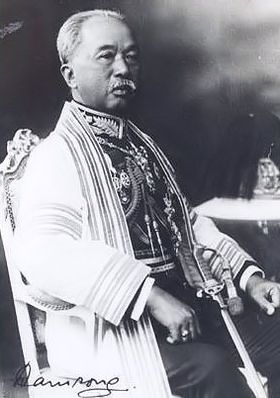
Abb.: His Royal Highness Prince Damrong (สมเด็จพระเจ้าบรมวงศ์เธอ
พระองค์เจ้าดิศวรกุมาร กรมพระยาดำรงราชานุภาพ)
[Bildquelle: th.Wikipedia. -- Public domain]
1934-01-12 ff.

Das Königspaar hält sich in Europa auf. Sie werden überall von den Staats- und Regierungsoberhäuptern empfangen. Sie besichtigen auch viele industrielle und landwirtschaftliche Anlagen. Sie besuchen
Abb.: Vom Königspaar besuchte Länder
[Bildquelle: Wikimedia. -- Public domain]
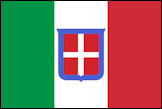
Rom (Italien):
Besuch bei
- Il Principe Vittorio Emanuele Ferdinando Maria Gennaro di Savoia, Principe Ereditario d’Italia (1869 - 1947)
Abb.: Il Principe Vittorio Emanuele Ferdinando Maria Gennaro di Savoia, Principe Ereditario d’Italia, 1936
[Bildquelle: Wikimedia. -- Public domain]
- Benito Amilcare Andrea Mussolini, Duce del Fascismo und Capo del Governo (1883 - 1945)
Abb.: Benito Amilcare Andrea Mussolini
[Bildquelle: Wikimedia. -- Public domain]

Vatikanstaat
Empfang durch Papst Pius XI. (Achille Ambrogio Damiano Ratti, 1857 - 1939)
Abb.: Pius XI., 1922

Frankreich. Präsident: Albert François Lebrun (1871 - 1950)
Abb.: Albert François Lebrun (1871 - 1950)
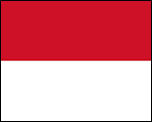
Monaco. Fürst: Louis II. von Monaco (Louis Honoré Charles Antoine Grimaldi, 1870 - 1949)
Abb.: Louis II. von Monaco (Louis Honoré Charles Antoine Grimaldi)
[Bildquelle: Wikimedia. -- Public domain]Königin Rambhai Barni (รำไพพรรณี, 1904 - 1984) sorgt als Tennisspielerin in Nizza (Frankreich) und Monte Carlo (Monacco) für Schlagzeilen. Sie spielt u. a. gegen den britischen Champion Henry Wilfred "Bunny" Austin (1906 – 2000).
Abb.: Lage von Nizza und Monte Carlo
[Bildquelle: OpenStreetMap. -- Creative Commons Lizenz (Namensnennung, share alike)]
Abb.: Henry Wilfred "Bunny" Austin mit Gattin, 1936
[Bildquelle: Willem van de Poll / Wikimedia. -- Creative Commons Lizenz (Namensnennung, share alike)]

Großbritannien. König: His Majesty George V [1865 - 1936], by the Grace of God, of Great Britain, Ireland and the British Dominions beyond the Seas, King, Defender of the Faith, Emperor of India
Abb.: His Majesty George V [1865 - 1936], by the Grace of God, of Great Britain, Ireland and the British Dominions beyond the Seas, King, Defender of the Faith, Emperor of India. 1936
[Bildquelle: Wikimedia. -- Public domain]Im Juni wird der König hier an einem Auge operiert. Er kommt wieder im September, da halten ihn die Ärzte für nicht stark genug für eine Operation am anderen Auge. Der König nimmt darauf für 6 Monate Urlaub in Surrey. Dort tritt er zurück.
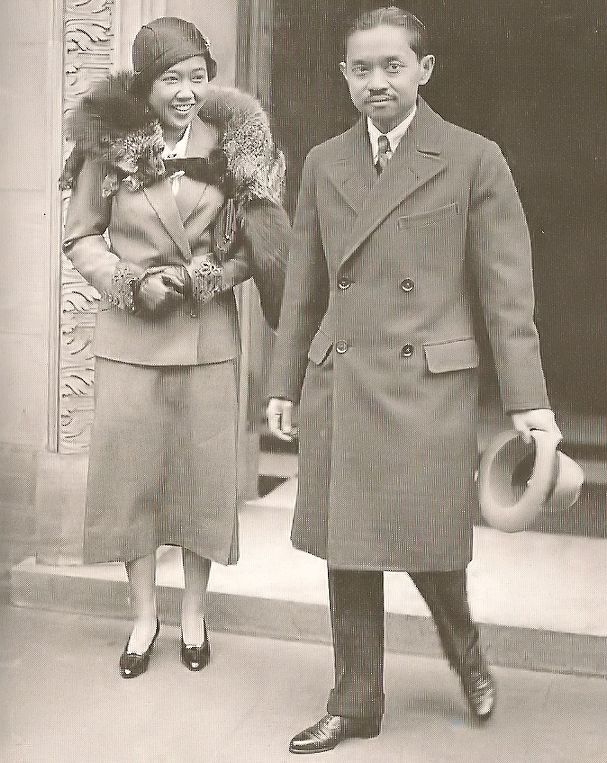
Abb.: Das Königspaar in London, 1934

Kopenhagen (Dänemark). König: Christian 10 Carl Frederik Albert Alexander Vilhelm (1870 - 1947), af Guds Nåde Konge til Danmark og Island, de Venders og Gothers, Hertug til Slesvig, Holsten, Stormarn, Ditmarsken, Lauenborg og Oldenborg
Abb.: Christian 10 Carl Frederik Albert Alexander Vilhelm, 1938
[Bildquelel: Wikimedia. -- Public domain]
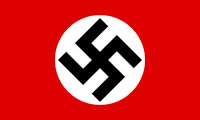
Berlin (Deutsches Reich). Reichpräsident: Paul Ludwig Hans Anton von Beneckendorff und von Hindenburg (1847 - 1934-08-02). Reichkanzler: Adolf Hitler (1889 - 1945)
Rama VII. und seine Gattin treffen 1934-07-02 im Deutschen Reich ein. Sie besuchen Berlin, treffen Adolf Hitler, und reisen weiter nach Bad Homburg.
Abb.: Rama VII. und Adolf Hitler, 1934-07
[Bildquelle: http://asiapacific.anu.edu.au/newmandala/wp-content/uploads/2012/05/Rama-VII-and-Hitler.jpg. -- Zugriff am 2013-11-24. -- Fair use]
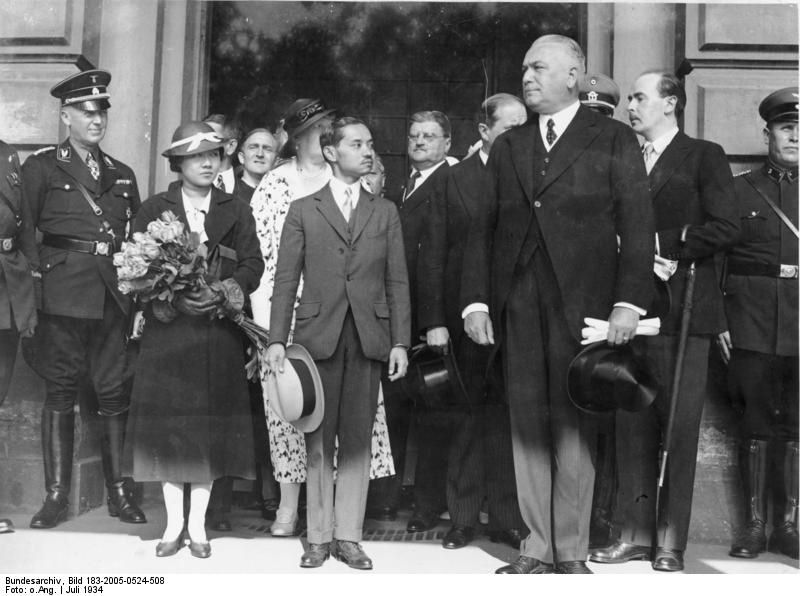
Abb.: Das Königspaar trifft auf dem Lehrter Bahnhof (Berlin) mit dem
fahrplanmäßigen D-Zug aus Hamburg ein, 1934-07
[Bildquelle: Bundesarchiv, Bild 183-2005-0524-508 / CC-BY-SA]
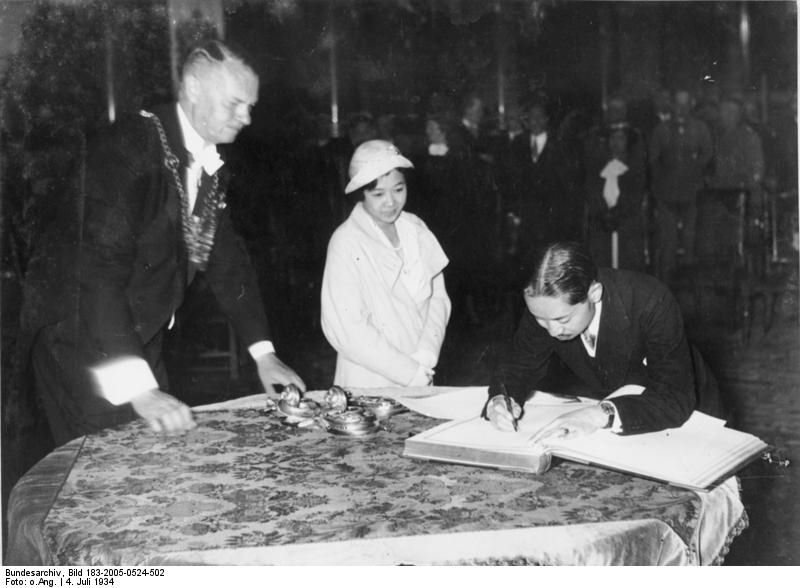
Abb.: Das Königspaar trägt sich ins Goldene Buch der Stadt Berlin ein,
1934-07-04
[Bildquelle: Bundesarchiv, Bild 183-2005-0524-502 / CC-BY-SA]
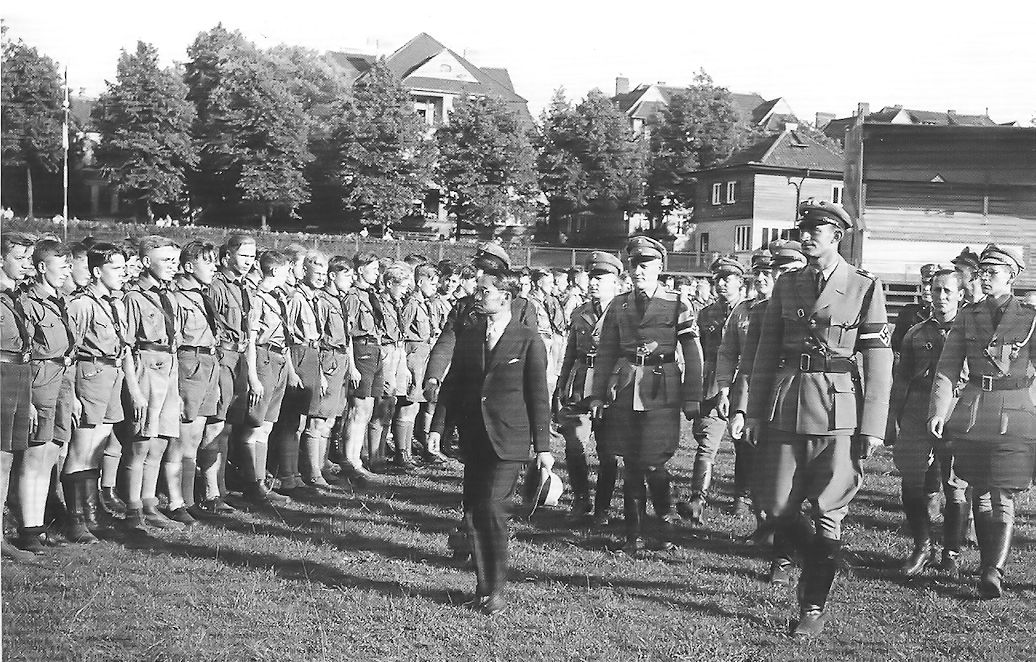
Abb.: König Rama VII. schreitet eine Ehrenformation der Hitlerjugend (HJ) ab,
1934
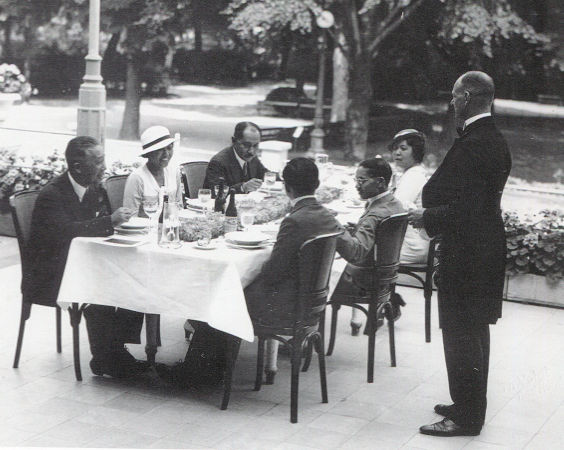
Abb.: König Rama VII. auf der Kur-Terrasse in Bad Homburg, 1934
[Bildquelle: Sawasdee : 150 Jahre Deutsch-Thailändische
Freundschaft, 50 Jahre Deutsch-Thailändische Gesellschaft / Andreas Stoffers
(Hrsg.). -- Rosenheim : Rosenheimer, 2012. -- 240 S. : Ill. ; 28 cm.
-- ISBN 978-3-475-54134-6. -- S. 57. -- Fair use]

Budapest (Ungarn). Reichsverweser: vitéz nagybányai Horthy Miklós (1868 - 1957)
Abb.: vitéz nagybányai Horthy Miklós und Adolf Hitler
[Bildquelle: Marianne / Wikimedia. -- Licence art libre (Copyleft)]
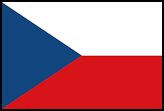
Prag (Tschechoslowakei). Staatspräsident: Tomáš Garrigue Masaryk (1850 - 1937)
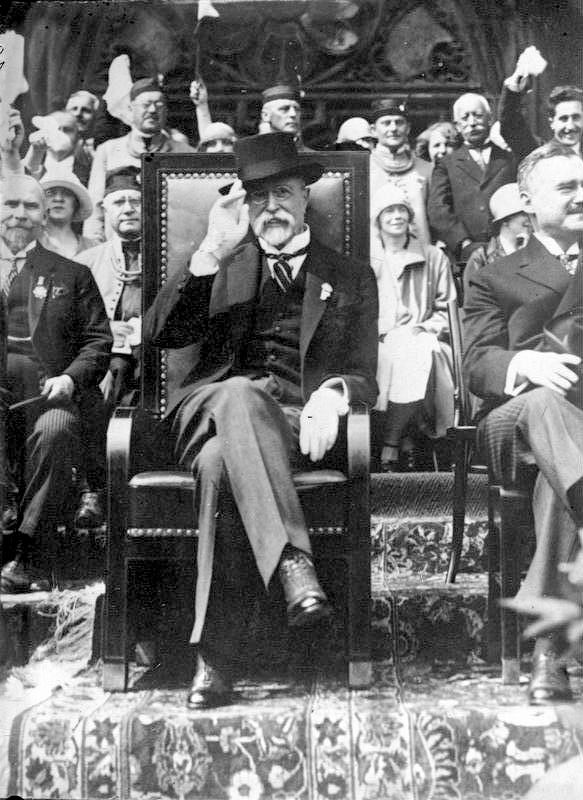
Abb.: Tomáš Garrigue Masaryk, 1932
[Bildquelle: Wikimedia/Bundesarchiv, Bild 102-13623 / CC-BY-SA 3.0]
1934-01-12 - 1935-03-02

Während der Abwesenheit des Königs ist von 1934-01-12 bis 1935-03-02 Prinz Narisara Nuvativongse (สมเด็จพระเจ้าบรมวงศ์เธอ เจ้าฟ้ากรมพระยานริศรานุวัดติวงศ์, 1863 - 1947) Regent (ผู้สำเร็จราชการแทนพระองค์).
Abb.: Prinz Narisara Nuvativongse (สมเด็จพระเจ้าบรมวงศ์เธอ เจ้าฟ้ากรมพระยานริศรานุวัดติวงศ์)
[Bildquelle: Wikipedia. -- Public domain]
"Prinz Naris ( Aussprache: [narít], vollständiger Titel: Prinz Narisara Nuvativongse, Thai: สมเด็จพระเจ้าบรมวงศ์เธอ เจ้าฟ้าจิตรเจริญ กรมพระยานริศรานุวัดติวงศ์ - Aussprache: [sŏm-dèt pʰrá-ʤâo boromma-wong-tə ʤâo-fáː ʤìt-ʤà-rən krom-pʰrá-ja ná-rít-ra-nú-wát-tì-wong]; * 28. April 1863 in Bangkok; † 10. März 1947 ebendort) war ein Prinz der noch heute amtierenden Chakri-Dynastie von Siam (heute: Thailand). Prinz Naris wurde am Dienstag, dem 28. April 1863 als der 62. Sohn von König Mongkut (Rama IV.) geboren, seine Mutter war die königliche Gemahlin Phannarai (พระสัมพันธวงศ์เธอ พระองค์เจ้าพรรณราย). Er war ein Halbbruder von König Chulalongkorn (Rama V.). Er war der Gründer des „Hauses von Chitrabhongse“ (ราชสกุลจิตรพงศ์) und hatte neun Söhne und Töchter.
Ab 1883 gewährte König Chulalongkorn seinem Halbbruder Prinz Naris das Recht, im Wang Tha Phra (วังท่าพระ) (Palast an der Buddha-Landungsbrücke) zu residieren. Aufgrund schlechter Gesundheit baute Naris 1914 vor der Stadt inmitten von Reisfeldern im heutigen Bangkoker Stadtteil Khlong Toei (คลองเตย) den Wang Plainoen (วังปลายเนิน) (Plainoen-Palast), den er dann bis zu seinem Tode im März 1947 bewohnte. [1]
Prinz Naris wird heute als der „Vater der thailändischen Künste“ bezeichnet. Er war ein talentierter Architekt, Maler, Bildhauer, Designer, Komponist und Musiker, er war ein Experte in thailändischer Geschichte und Archäologie. Sein künstlerisches Genie und seine Beiträge zur Entwicklung der thailändischen Künste veranlasste 1963 die UNESCO, ihn zu einer „Person von internationaler Bedeutung“ zu ernennen. [2]
Seit 2005 wird alljährlich von der Silpakorn-Universität (มหาวิทยาลัยศิลปากร) ein Foto-Wettbewerb ausgeschrieben, um Kreativität und Innovation der fotografischen Künste zu fördern. Er wird zu Ehren des meisterlichen Künstlers und Handwerkers „Prinz-Naris-Tag“ genannt. [2]
ErrungenschaftenLiteratur
- Er schrieb den Text der ersten Version der Nationalhymne, der heutige „Königshymne“ Phleng San Soen Phra Barami (เพลงสรรเสริญพระบารมี).
- Er entwarf 1947 das noch heute benutzte Siegel der Stadtverwaltung Bangkok (BMA), auf dem der Hindu-Gott Indra mit seinem Reittier, dem mythologischen Elefanten Erawan (เอราวัณ) dargestellt ist.
- Er entwarf den Ubosot (พระอุโบสถ) des Wat Benchamabophit (วัดเบญจมบพิตร ดุสิตวนาราม ราชวรวิหาร) und ließ ihn mit italienischem Marmor verkleiden. Daher wird dieser Tempel auch „Marmor-Tempel“ genannt.
- Unter seiner Leitung wurde auf Ko Sichang (เกาะสีชัง) der dort 1868 errichtete Mantat-Rattana-Rojana-Palast abgetragen und in König Chulalongkorns neuen Phra Ratchawang Dusit (พระราชวังดุสิต) (Dusit-Palast) als Wimanmek-Palast (พระที่นั่งวิมานเมฆ) wieder aufgebaut. Das Palast-Gebäude wurde am 27. März 1901 eingeweiht.
- Er ließ seinen Palast (วังท่าพระ) (Wang Tha Phra) renovieren, indem er baufällige Gebäude abreißen und neue in einem europäisch-siamesischem Stil errichten ließ.
- Er entwarf den Ubosot des Wat Ratchathiwat, (วัดราชาธิวาสวิหาร) dem Tempel, in dem sein Vater einen Teil seiner Mönchszeit verbrachte. Unter der Leitung von Prinz Naris wurde auch die Studierhalle (Sala Kan Parian) des Tempels renoviert. [3]
- Er entwarf das „Thawon-Watthu-Gebäude“ am Sanam Luang (สนามหลวง), welches zunächst als temporäres Gebäude für die Kremation von Kronprinz Chaofah Maha Wachirunnahit vorgesehen war. König Vajiravudh (Rama VI.) richtete später in ihm die Stadtbibliothek von Bangkok („Hor Phra Samut Vajiravudh“) ein. 1977 wurde es vom thailändischen Fine Arts Department (กรมศิลปากร) als „Nationales Antikes Gebäude“ gelistet. [4]
- König Vajiravudh fand im Jahre 1909, als er noch Kronprinz war, in Si Satchanalai (ศรีสัชนาลัย) Bruchstücke einer großen Buddha-Statue, von der nur der Kopf, Hände und Füße unversehrt waren. Prinz Naris wurde beauftragt, die Statue zu restaurieren. Sie wurde 1913 im Wat Pho (วัดโพธิ์) in Bangkok gegossen. Am 2. November 1915 wurde die Statue in der nördlichen Kapelle der Phra Pathom Chedi (พระปฐมเจดีย) unter dem Namen „Phra Ruang Rojanaridhi“ eingeweiht. Später wurden die sterblichen Überreste von König Vajiravudh im Sockel dieser Statue beigesetzt.
- Er entwarf auf Anordnung von König Prajadhipok (Rama VII.) die Statue von König Phra Phuttayodfa Chulalok (Rama I.), welche heute auf dem östlichen Ufer des Maenam Chao Phraya (แม่น้ำเจ้าพระยา) am Fuße der der Phra Phuttha Yodfa-Brücke (สะพานพระพุทธยอดฟ้า) steht.
- A.B. Griswold: King Mongkut Of Siam. The Asia Society, New York 1961, distributed by The Siam Society Bangkok
- Prince Chula Chakrabongse of Thailand: Lords Of Life, The Paternal Monarchy Of Bangkok. Alvin Redman Ltd., London 1960"
[Quelle: http://de.wikipedia.org/wiki/Naris. -- Zugriff am 2012-04-02]
1934-01-05
Einweihung des Denkmals für Thao Suranari (ท้าวสุรนารี, 1772 - 1852) von Silpa Bhirasri (ศิลป์ พีระศรี = Corrado Feroci, 1882 - 1962) in Korat (โคราช)
Abb.: Statue von Thao Suranari (ท้าวสุรนารี, 1772 - 1852) / von Silpa Bhirasri (ศิลป์ พีระศรี = Corrado Feroci), Korat (โคราช)
[Bildquelle: Thanyakij / Wikipedia. -- Public domain]
Abb.: Einweihung des Denkmals für Thao Suranari (ท้าวสุรนารี, 1772 - 1852) von Silpa Bhirasri (ศิลป์ พีระศรี = Corrado Feroci, 1882 - 1962) in Korat (โคราช), 1934-01-05
Abb.: Lage von Korat (โคราช)
[Bildquelle: OpenStreetMap. -- Creative Commons Lizenz (Namensnennung, share alike)]
"Thao Suranari (in Thai: ท้าวสุรนารี; * 1772; † 1852) war die Ehefrau des Gouverneurs von Nakhon Ratchasima (นครราชสีมา). Mit 25 Jahren heiratete sie den Gouverneur von Korat (in anderen Quellen auch Festungskommandant genannt). Ihr Name ist Khun Ying Moo (คุณหญิงโม), wobei Moo (โม) Melone bedeutet (Dtaeng Moo) und der vorangestellte Titel Khun Ying noch heute den Namen von Ehefrauen hoher Persönlichkeiten (z. B. Gouverneure, Premierminister, etc.) vorangestellt wird. Den Titel Thao Suranari wurde ihr später von König Nang Klao (Rama III.) verliehen. Als der laotische König Anouvong (ເຈົ້າອານຸວົງ) 1826 mit seinen Truppen die Stadt eroberte, veranstaltete sie mit anderen Frauen ein Trinkgelage außerhalb der Stadt und griff anschließend die betrunkenen Soldaten an. Nach einem Monat konnten so die Laoten vertrieben werden.
Seit dem 5. Januar 1934 steht eine Statue vor dem alten Stadttor (Pratu Chumphon - ประตูชุมพล) von Nakhon Ratchasima. Das Denkmal ist 1,85 m hoch (ohne Sockel) und wurde von dem Künstler Silpa Bhirasri (ศิลป์ พีระศรี = Corrado Feroci, 1882 - 1962) erstellt.
Sie wird von der Bevölkerung als „Großmutter Mo“ oder „Ya Mo“ (ย่าโม) sehr verehrt, ihr zu Ehren wird jedes Jahr Ende März/Anfang April ein 10-tägiges Fest, die „Thao Suranari Fair“ gefeiert."
[Quelle: http://de.wikipedia.org/wiki/Thao_Suranari. -- Zugriff am 2011-11-15]
1934-01-12
Charoen Subsaeng (เจริญสืบแสง, 1902 - 1969) laut Bangkok Times Weekly Mail:
"If I wanted to shoot Phya Mano [Phraya Manopakorn Nititada - พระยามโนปกรณ์นิติธาดา, 1884 - 1948], Phya Sri Visarn [Phraya Sri Visarn Vacha (Srivisarn Huntrakul) - พระยาศรีวิสารวาจา (หุ่น ฮุนตระกูล), 1896 - 1968] or Prayoon [Prayoon Pamornmontri - ร.ท. ประยูร ภมรมนตรี, 1897 - 1982], I would let them know in advance ... I know that shooting in the Assembly is not a good thing ... It seems to me, however, that the soldiers are not posted here as guards, but as a challenge . . . What is the real purpose of this? Do you want to use the soldiers to close the Assembly in order to prevent a vote of confidence?" [Zitiert in: Stowe, Judith A. <1934 - 2007>: Siam becomes Thailand : a story of intrigue. -- Honolulu : Univ. of Hawaii Pr., 1991. -- 394 S. : Ill. ; 22 cm. -- ISBN 0-8248-1394-4. -- S. 41f.]
1934-02-10


Das Königspaar kommt in Marseille an und reist weiter nach Beaulieu-sur-Mer
Abb: Lage von Marseille und Beaulieu-sur-Mer
[Bildquelle: OpenStreetMap. -- Creative Commons Lizenz (Namensnennung, share alike)]

"Während in Bangkok gemeldet wurde, dass König Prajadhipok und Königin Ramphai am 10. Februar 1934 in Marseille angekommen und noch am selben Tag weiter nach Beaulieu gereist seien, fingen die Firmen in Deutschland an, Briefe an das Auswärtige Amt zu senden, um das Amt von einem Werksbesuch des Königspaars bei ihnen zu überzeugen. Zu den Firmen, die solche Briefe an das Auswärtige Amt schickten, gehörten bedeutende Firmen wie
- die Robert Bosch A.G. aus Stuttgart,
- die Anschütz & Co. G.M.B.H Werkstatt für Kreiselkompasse aus Kiel-Neumühlen,
- die I.G. Farbenindustrie Aktiengesellschaft aus Frankfurt am Main,
- die Carl Lindström Aktiengesellschaft aus Berlin, die Schallplatten herstellte und bereits in den vergangenen Zeiten viele Schallplatten-Aufnahme von Angehörigen des siamesischen Königshauses gemacht hatte.
Dazu
- die Zeiss-Ikon-Aktiengesellschaft aus Dresden,
- die Daimler-Benz Aktiengesellschaft, die in ihrem Brief auch hinwies, dass „Seine Majestät der König von Siam als ein treuer und zufriedener Kunde unseres Hauses" bezeichnet werden könnte,
- die Carl Zeiss aus Jena,
- die Köhler & Volckmar A.G. & Co. aus Leipzig, die Schuleinrichtungen und Lehrmittel anbot, sowie
- die Kommanditgesellschaft auf Aktien, Krause aus Leipzig.
Alle genannten Firmen wiesen in ihren Briefen daraufhin, dass ihre Vertreter in Siam sie auf den Besuch des siamesischen Paares in Deutschland aufmerksam gemacht hatten."
[Quelle: Catthiyakorn Sasitharamas [คัททิยากร ศศิธรามาส]: Die deutsch-thailändischen Beziehungen in der Zeit der Weimarer Republik bis zum Ende des Zweiten Weltkriegs. -- Hamburg : Kovač, 2012. -- 346 S. ; 21 cm. -- (Schriftenreihe Schriften zur Geschichtsforschung des 20. Jahrhunderts ; Bd. 4). -- ISBN 978-3-8300-6361-2. -- Zugl.: Hamburg, Univ., Diss., 2012. -- S. 241f. -- Fair use]
1934-02-20

Der deutsche Gesandte Erich August Karl Nord (1881 - 1935) ans Auswärtige Amt:
"Dass auch nach dem Staatstreich das deutsche Militär sich in Siam einer großen Wertschätzung erfreute, zeigte ebenfalls ein Bericht vom Gesandten Nord an das Auswärtige Amt vom 20. Februar 1934. In diesem Bericht hob der Gesandte Nord hervor, dass der derzeitige Ministerpräsident Siams, Phraya Phahol, „der seine Jugend in einer deutschen Kadettenanstalt verbracht hat und noch heute als einzige Fremdsprache Deutsch spricht",
allen deutschen kulturellen Bestrebungen in Siam überaus freundlich gegenüber gesinnt sei. Sein immer noch großes Interesse an der deutschen Kultur bekunde der Ministerpräsident durch seine häufige Teilnahme an gemeinschaftlichen deutsch-siamesischen Veranstaltungen."
[Quelle: Catthiyakorn Sasitharamas [คัททิยากร ศศิธรามาส]: Die deutsch-thailändischen Beziehungen in der Zeit der Weimarer Republik bis zum Ende des Zweiten Weltkriegs. -- Hamburg : Kovač, 2012. -- 346 S. ; 21 cm. -- (Schriftenreihe Schriften zur Geschichtsforschung des 20. Jahrhunderts ; Bd. 4). -- ISBN 978-3-8300-6361-2. -- Zugl.: Hamburg, Univ., Diss., 2012. -- S. 259. -- Fair use]
1934-02-23
Prinz Devawongs Varodaya (พระวรวงศ์เธอ พระองค์เจ้าไตรทศประพันธ์ กรมหมื่นเทววงศ์วโรทัย, 1883 - 1943) an Francis Bowes Sayre (1885 - 1972) über die Boworadet-Revolte:
"The rising would have been successful if Prince Bovoradej [พระเจ้าบรมวงศ์เ้ธอ พระองค์เจ้าบวรเดช, 1877 - 1953] (whom I think you know) hadn’t taken part as leader. He is not popular and is credited with the idea of establishing a military dictatorship. There were many factions and groups of men beside his own who hated the present Government and were ready to help to overthrow the Government, but as soon as it was learnt that Prince Bovoradej was leading the troops from Korat, many of them, especially those of Bangkok, abstained. The Government was able, therefore, to defeat Prince Bovoradej and his friends who have taken refuge in French Indochina. Prince Bovoradej has really done a lot of harm to the cause of the Princes. He shouldn’t have taken part, but should have let his friends do it in co-operation with the other groups." [Zitiert in: Batson, Benjamin Arthur <1942 - >: The end of the absolute monarchy in Siam. -- Singapore : Oxford Univ. Pr., 1984. -- 349 S. : Ill. ; 22 cm. -- (Southeast Asia publications series ; no. 10). -- ISBN 0-19-582612-4. -- S. 249]
1934-02-23

Die Die Akademie zur Wissenschaftlichen Erforschung und Pflege des Deutschtums (Deutsche Akademie) <München> bildet einen Siam-Ausschuss. Die Deutsche Akademie ist der Vorläufer der Goethe-Institute.
"Etwa ein Jahr nach der Gründung der siamesisch-deutschen Vereinigung in Bangkok rief die „deutsche Akademie, Akademie zur wissenschaftlichen Erforschung und zur Pflege des Deutschtums", aufgrund der wachsenden Beliebtheit der deutschen Sprachkurse in Siam sowie zum Teil wegen des bevorstehenden Besuchs des siamesischen Königspaars in Deutschland409 den siamesischen Ausschuss ins Leben. In ihrem Brief an ihre Mitglieder vom 23. Februar 1934 teilte die Deutsche Akademie, die sich „die Pflege der Kulturbeziehungen zwischen Deutschland und anderen Ländern zur besonderen Aufgabe" machte, den Letzteren mit, dass der siamesische Ausschuss nach dem Vorbild ihrer bereits bestehenden Länderausschüsse für Nordamerika, England, Indien, Südamerika und Südafrika aufgebaut werden sollte. Unter dem Vorsitz von Prof. Dr. [Karl Ernst] Haushofer [1869 - 1946] und maßgebenden Beratungen von Prof. Dr. [Wilhelm] Credner [1892 - 1948], der zu dieser Zeit Vorsitzende der geographischen Gesellschaft in München war und aufgrund seines langen Aufenthalts im Land sich mit Siam sehr gut auskannte, hatte laut der deutschen Akademie der Ausschuss die Aufgabe: „Die Verstärkung persönlicher Beziehungen zwischen Deutschland und Siam auf akademischem und wirtschaftlichem Gebiete:
- Heranziehung junger Siamesen an deutsche Hochschulen,
- Unterbringung geeigneter Angehöriger wirtschaftlicher und industrieller Berufe in deutschen Werken,
- Einladung hervorragender siamesischer Persönlichkeiten gelegentlich ihrer Besuche in Europa nach Deutschland,
- Belieferung der wichtigen siamesischen Zeitungen mit kulturellen und wirtschaftlichen Beiträgen aus Deutschland,
- Entsendung hervorragender Persönlichkeiten zu Forschungen und Vorträgen nach Siam,
- Auszeichnung siamesischer Persönlichkeiten, die sich um die deutsch-siamesischen Beziehungen verdient gemacht haben,
- Förderung des deutschen Sprachunterrichts an siamesischen Schulen durch Entsendung deutscher Sprachlehrer,
- Weckung des Interesses für Siam in Deutschland,
- usw."
Dabei bemerkte die deutsche Akademie in ihrem Brief, dass der siamesische Ausschuss sich allein schon wegen der Satzung der Akademie von jeden aktiven politischen Aktivitäten fernhalten werde. Er werde dann ausschließlich auf geistigem Gebiet für eine freundschaftliche Zusammenarbeit zwischen den beiden Ländern wirken."
[Quelle: Catthiyakorn Sasitharamas [คัททิยากร ศศิธรามาส]: Die deutsch-thailändischen Beziehungen in der Zeit der Weimarer Republik bis zum Ende des Zweiten Weltkriegs. -- Hamburg : Kovač, 2012. -- 346 S. ; 21 cm. -- (Schriftenreihe Schriften zur Geschichtsforschung des 20. Jahrhunderts ; Bd. 4). -- ISBN 978-3-8300-6361-2. -- Zugl.: Hamburg, Univ., Diss., 2012. -- S. 292f. -- Fair use]
1934-03

Abb.: Lage von Wat Duangkhae [วัดดวงแข]
[Bildquelle: OpenStreetMap. -- Creative Commons Lizenz (Namensnennung, share alike)]
"A few years later, in March 1934, La Sophito and his fellow monks took power from the abbot of Wat Duangkhae [วัดดวงแข] and the wat committee. This time Somdet Cheun [วชิรญาณวงศ์ (ม.ร.ว. ชื่น นพวงศ์ สุจิตฺโต), 1872 - 1958], head of the Thammayut order [ธรรมยุติกนิกาย], became acting supreme patriarch. He asked the director-general of the Religious Affairs Department to punish the rebellious monks according to the rules. With no investigation into the reasons for their rebellion, La and his fellow monks were defrocked. Since Phrommuni (Uan) [พระมหาวีรวงศ์ (อ้วน ติสฺโส), 1868 - 1956] refused to administer this wat and the senior Thammayut monks could not find a suitable abbot, they decided to close the temple." [Quelle: Kamala Tiyavanich [กมลา ติยะวนิช] <1948 - >: Forest recollections : wandering monks in twentieth-century Thailand. -- Honolulu : Univ. of Hawai’i Pr., 1997. -- ISBN 0824817818. -- S. 190f. -- Faire use]
1934-03
Die Nationalversammlung beschließt bei den Pensionen 287.000 Baht zu sparen. Dies führt zu Pensionskürzungen zwischen 10% (bei 200 Baht Monatspension) bis 50% (bei 1300 Baht und mehr Monatspension). Diese Pensionskürzungen setzt die Nationalversammlung mit 64 zu 34 Stimmen gegen den Willen der Regierung durch.
Die Nationalversammlung kritisiert auch die übliche Praxis, hohe Beamtenstellen mit Militärs zu besetzen.
Die Nationalversammlung kritisiert auch, dass die Gouverneure der Provinzen ernannt und nicht gewählt werden, die Gouverneure die Subalternbeamten autokratisch ernennen. Mit 50 zu 12 Stimmmen beschließt sie, dass die Gouverneure gewählt werden müssen, "sodass sie Vertreter und nicht Herren des Volkes sind".
1934-03

Der britische Finanzberater James Baxter (1896 - ) über die Revolutionsregierung:
"In fact, however, nothing whatsoever has been done since the change of regime in June 1932 except a somewhat meagre extension of road, railway and irrigation construction and an increase in the number of co-operative societies. The new regime is carrying out the programmes elaborated by the old. It has itself initiated nothing." [Zitiert in: Batson, Benjamin Arthur <1942 - >: The end of the absolute monarchy in Siam. -- Singapore : Oxford Univ. Pr., 1984. -- 349 S. : Ill. ; 22 cm. -- (Southeast Asia publications series ; no. 10). -- ISBN 0-19-582612-4. -- S. 280, Anm. 156]
1934-03

Die Londoner Zeitung Daily Express berichtet, dass es auf der malaiischen Halbinsel von japanischen Spionen wimmelt; dass Siam wünscht, den britischen Finanzberater durch einen japanischen zu ersetzen; dass Siam eine Allianz mit Japan möchte; dass Japan eine Marinebasis im Isthmus von Kra (คอคอดกระ) möchte.
Abb.: Lage des Isthmus von Kra (คอคอดกระ)
[Bildquelle: Bartholomew, J. G. <1860 - 1920>: A literary & historical atlas of Asia. -- London, o. J.]
1934-03-10
Eine Kommission spricht Pridi vom Vorwurf des Kommunismus frei. Vorsitzender der Kommission ist Prinz Wan Waithayakon (พระเจ้าวรวงศ์เธอ พระองค์เจ้า วรรณไวทยากร กรมหมื่นนราธิปพงศ์ประพันธ์, 1891 -1976). Weitere Mitglieder sind der französische Rechtberater René Guyon (aka. Pichan Bulayong - พิชาญ บุลยง, 1876 - 1963) und Sir Robert E. Holland.
1934-03-12 - 1934-04-04

Das Königspaar ist auf halboffiziellem Besuch im Königreich Italien
Abb.: Benito Amilcare Andrea Mussolin
[Bildquelle: Wikimedia. -- Public domain]
"„After several weeks spent on the French Riviera, the King and Queen of Siam arrived in Rome in early March".
Nach Meldung der deutschen Botschaft in Rom wurde das Königspaar schon in San Remo von einer Abordnung begrüßt, die sich
„aus einem der Generaladjutanten des Italienischen Königs, einem Hofzeremonienmeister, dem Chef des Zeremonialamts des Außenministeriums und einem anderen hohen Beamten dieses Ministeriums zusammensetzte und die fremden Gäste in dem ihnen zur Verfügung gestellten Sonderzug nach der Hauptstadt begleitete".
In Rom zum halboffiziellen Besuch eingetroffen, seien die königlichen Gäste am Bahnhof vom italienischen Kronprinzen [Umberto Nicola Tommaso Giovanni Maria di Savoia, 1904 - 1983], [Benito Amilcare Andrea] Mussolini [1883 - 1945] sowie den hohen Beamten der Stadt empfangen worden. Wie die deutsche Botschaft in Rom weiterhin berichtete, hätten alle öffentlichen Gebäude zu Ehren der Gäste geflaggt und am Abend seien sie reichlich illuminiert gewesen. Ebenfalls habe das italienische Königspaar Presseberichten zufolge die siamesischen Gäste empfangen und ihnen am 12. März 1934 im Quirinal ein Frühstück gegeben, an dem auch Ministerpräsident Mussolini teilgenommen habe. Damit sei der halboffizielle Besuch in Italien beendet worden und das weitere Bleiben des siamesischen Königspaars in Italien könne als privat bezeichnet werden.
Am nächsten Tag seien König Prajadhipok und Königin Ramphai vom Generalsekretär der faschistischen Partei im Palazzo Littorio, dem Sitz der Partei selbst, empfangen worden. Anschließend habe ein Teeempfang beim Gouverneur von Rom stattgefunden, an dem das ganze diplomatische Korps teilgenommen habe. Am 14. März 1934 meldeten die Zeitungen, dass König Prajadhipok eine längere und freundliche Unterredung mit Mussolini geführt habe. Danach habe das siamesische Königspaar die Sehenswürdigkeiten Roms, u.a. den Palatin sowie das Forum Romanum, besucht.
[...]
Nach dem Besuch beim Papst im Vatikan am 22. März 1934 und einem kurzen Aufenthalt in Neapel und Turin, begaben sich König Prajadhipok und Königin Ramphai weiter nach Paris, wo sie am 5. April 1934 ankamen."
[Quelle: Catthiyakorn Sasitharamas [คัททิยากร ศศิธรามาส]: Die deutsch-thailändischen Beziehungen in der Zeit der Weimarer Republik bis zum Ende des Zweiten Weltkriegs. -- Hamburg : Kovač, 2012. -- 346 S. ; 21 cm. -- (Schriftenreihe Schriften zur Geschichtsforschung des 20. Jahrhunderts ; Bd. 4). -- ISBN 978-3-8300-6361-2. -- Zugl.: Hamburg, Univ., Diss., 2012. -- S. 242ff. -- Fair use]
1934-03-14
Die Nationalversammlung verabschiedet das Gesetz über die Bildung einer Universität für moralische und politische Wissenschaften (Thammasat-Universität - มหาวิทยาลัยธรรมศาสตร์ ). Pridi wird am 1934-04-11 der erste Rektor und hält diese Stellung bis die Regierung im März 1952 die Stelle eines Rektors strich.
Abb.: Lage der Thammasat-Universität (มหาวิทยาลัยธรรมศาสตร์)
[Bildquelle: OpenStreetMap. -- Creative Commons Lizenz (Namensnennung, share alike)]Die Thammasat-Universität hat auch ein Fernkurs-Departement. 1936/37 nahmen 77 Studierende am Fernunterricht teil und waren 14 Tage vor Ort.
Abb.: 1984-07-03 errichtete Statue für ปรีดี พนมยงค์ - Dr. Pridi Banomyong (1900 – 1983)
[Bildquelle: Xiengyod / Wikimedia. -- GNU FDLicense]
"It is doubtless that the University of Moral and Political Science in Bangkok plays an important role in the educational advancement of Siam, and its activities should be worthy of special mention in the progressive march of this country along the lines of the present constitutional regime. The smooth and efficient functioning of a parliamentary regime requires not only enlightened voters but also an intelligentsia capable of taking part in the direction of public affairs, and to whom the voters may grant their confidence for the administration of the country. One of the main problems of the Constitutional government has been to carry out a comprehensive educational policy, fulfilling both the requirements, and while the compulsory primary education scheme was enforced and other progressive measures initiated in regard to public enlightenment, the new University of Moral and Political Science was created to promote the knowledge of legal and political sciences among the growing population." [Quelle: Siam Chronicle. -- 1937-06-10. -- Zitiert in Landon (1939), S. 110]
1932 - 1975
Studierende an thailändischen Universitäten 1932 - 1975
Abb.: Studierende an thailändischen Universitäten 1932 - 1975
[Datenquelle: Mitchell (1982), S. 713]
1934-03-16

Ministerpräsident Phahon in einer Rede in Korat (โคราช) über die Bedeutung des Buddhismus für die Erziehung:
"The bond between religion and country and that between the temple and the home will be rendered more intimate by depending on education as the proper medium. The teaching of good behaviour to the children of the land, along with physical, verbal, and mental training, should constitute the fundamental aim of education. The Dharma of the Great Teacher constitutes the best method for education in this direction. The monk is acknowledged to be learned and conducts himself according to Dharma and hence it is that there is none more worthy than he to impart such a training to children. . . . The idea of giving a normal training to monks so that they may assist the education of the children of the land henceforth is indeed a most excellent one in these difficult days."
[Quelle: Bangkok Times. -- 1934-03-16. -- Zitiert in: Landon (1939), S. 109]
Abb.: Lage von Korat (โคราช)
[Bildquelle: OpenStreetMap. -- Creative Commons Lizenz (Namensnennung, share alike)]
1934-03-22

Vatikan: Das siamesische Königspaar wird von Papst Pius XI. (1857 - 1939) empfangen.
Abb.: Pius XI., 1933
[Bildquelle: Wikimedia. -- Public domain]
1934-03-22

In einem Memorandum an das Foreign Office schreibt der britische Vizekonsul Whittington, dass Luang Phibulsongkram (พิบูลสงคราม, 1897 - 1964) der mächtigste man in Siam war
because "he has the tanks and all the arms. He was a soldier not a poltician." [Zitiert in: Charivat Santaputra [จริย์วัฒน์ สันตะบุตร]: Thai foreign policy 1932-1946. -- Bangkok : Thai Khadi Research Institute, Thammasat University, 1985. -- 465 S. ; 21 cm. -- ISBN 974-335-091-8. -- S. 145]
1934-03-Ende

Wegen eines (angeblichen?) Putschversuchs werden über 100 Personen verhaftet, darunter der Führer der Bangkok Taxi Drivers' Association.
ausführlich: http://www.payer.de/thailandchronik/ressourcen.htm
Thai politics : extracts and documents 1932 - 1957 / ed. by Thak Chaloemtirana <ทักษ์ เฉลิมเตียรณ>. -- Bangkok : Social Science Ass., 1978. -- 884 S. ; 25 cm.
Landon, Kenneth Perry <1903 - 1993>: Siam in transition : a brief survey of cultural trends in the five years since the revolution of 1932. -- Chicago : Univ. of Chicago Press, 1939. -- 328 S. ; 24 cm.
Thawatt Mokarapong [ธวัช มกรพงศ์] <1932 - >: History of the Thai revolution : a study in political behaviour. -- Bangkok : Chalermnit, 1972. -- 251 S. : 21 cm.
Thompson, Virgina <1903 - 1990>: Thailand the new Siam. -- New York : Macmillan, 1941. -- 865 S. : 24 cm.
Phongpaichit, Pasuk <ผาสุก พงษ์ไพจิตร, 1946 - > ; Baker, Chris <1948 - >: Thailand : economy and politics. -- Selangor : Oxford Univ. Pr., 1995. -- 449 S. ; 23 cm. -- ISBN 983-56-0024-4. -- Beste Geschichte des modernen Thailand.
Ingram, James C.: Economic change in Thailand 1850 - 1870. -- Stanford : Stanford Univ. Pr., 1971. -- 352 S. ; 23 cm. -- "A new edition of Economic change in Thailand since 1850 with two new chapters on developments since 1950". -- Grundlegend.
Akira, Suehiro [末廣昭] <1951 - >: Capital accumulation in Thailand 1855 - 1985. -- Tokyo : Centre for East Asian Cultural Studies, ©1989. -- 427 S. ; 23 cm. -- ISBN 4896561058. -- Grundlegend.
Skinner, William <1925 - 2008>: Chinese society in Thailand : an analytical history. -- Ithaca, NY : Cornell Univ. Press, 1957. -- 459 S. ; 24 cm. -- Grundlegend.
Mitchell, B. R. (Brian R.): International historical statistics : Africa and Asia. -- London : Macmillan, 1982. -- 761 S. ; 28 cm. -- ISBN 0-333-3163-0
Thailand in figures 2000 - 2001. -- Bangkok : Alpha, 2000. -- 934 S. : Ill. ; 30 cm. -- ISBN 974-87738-1-7